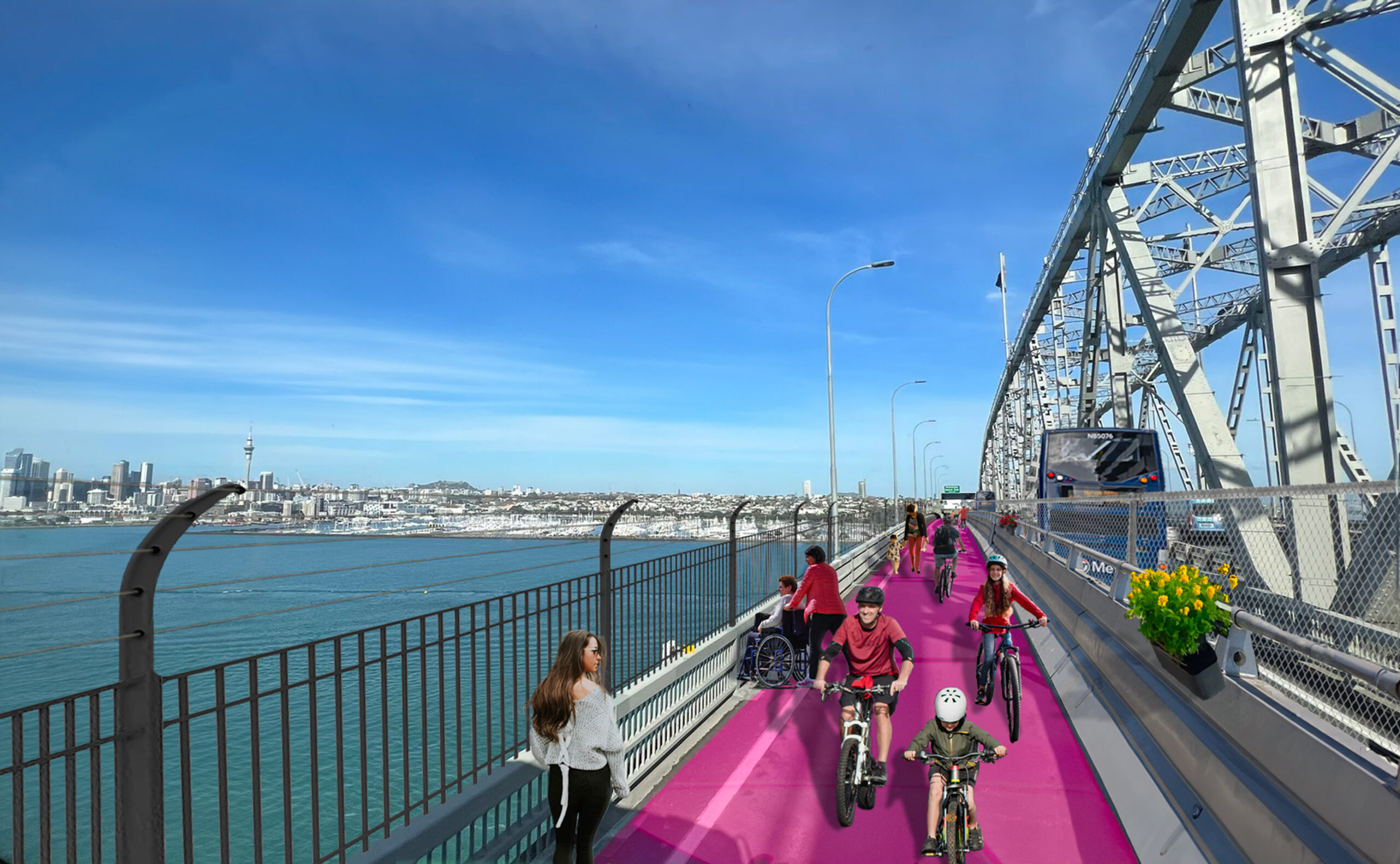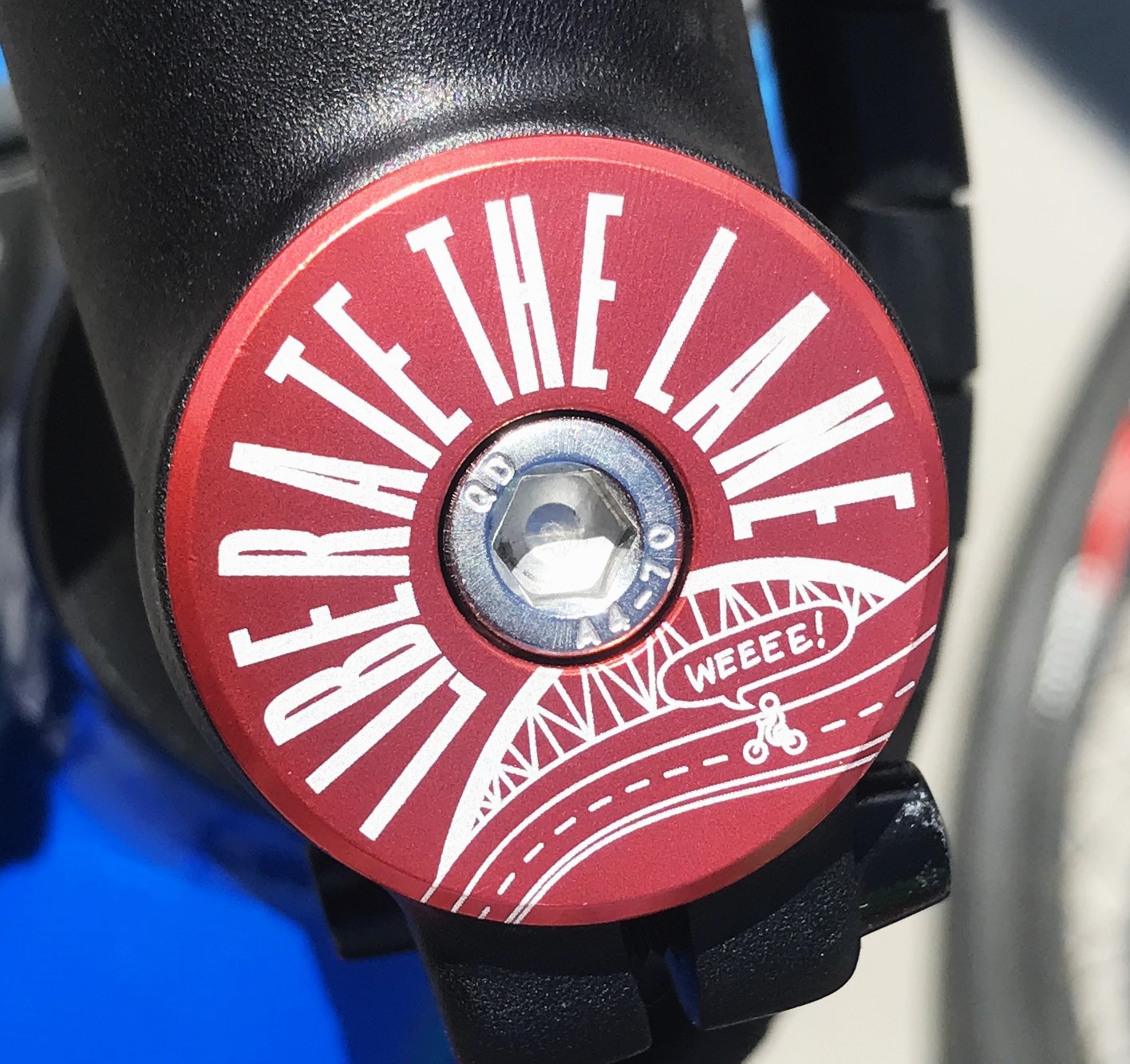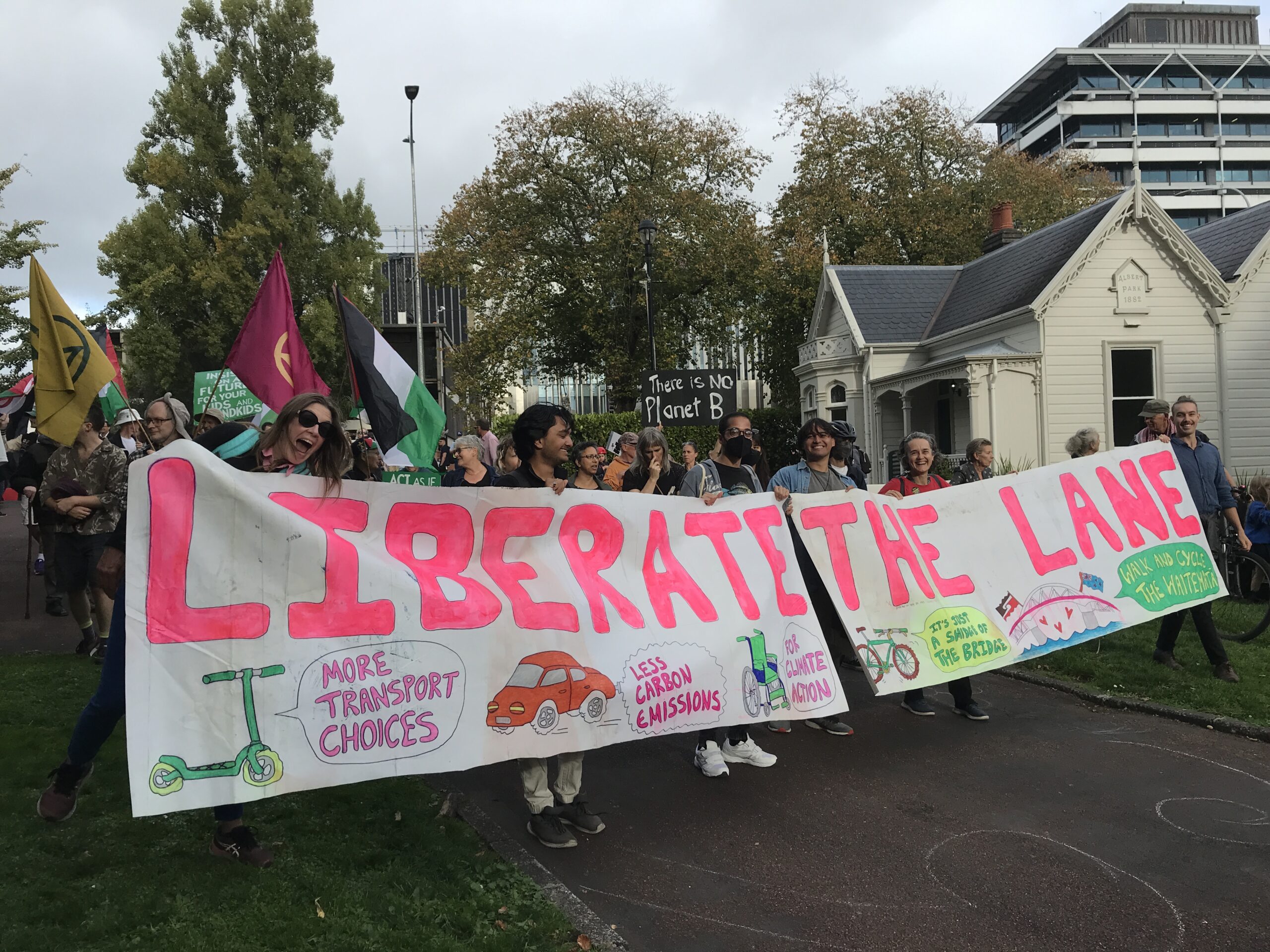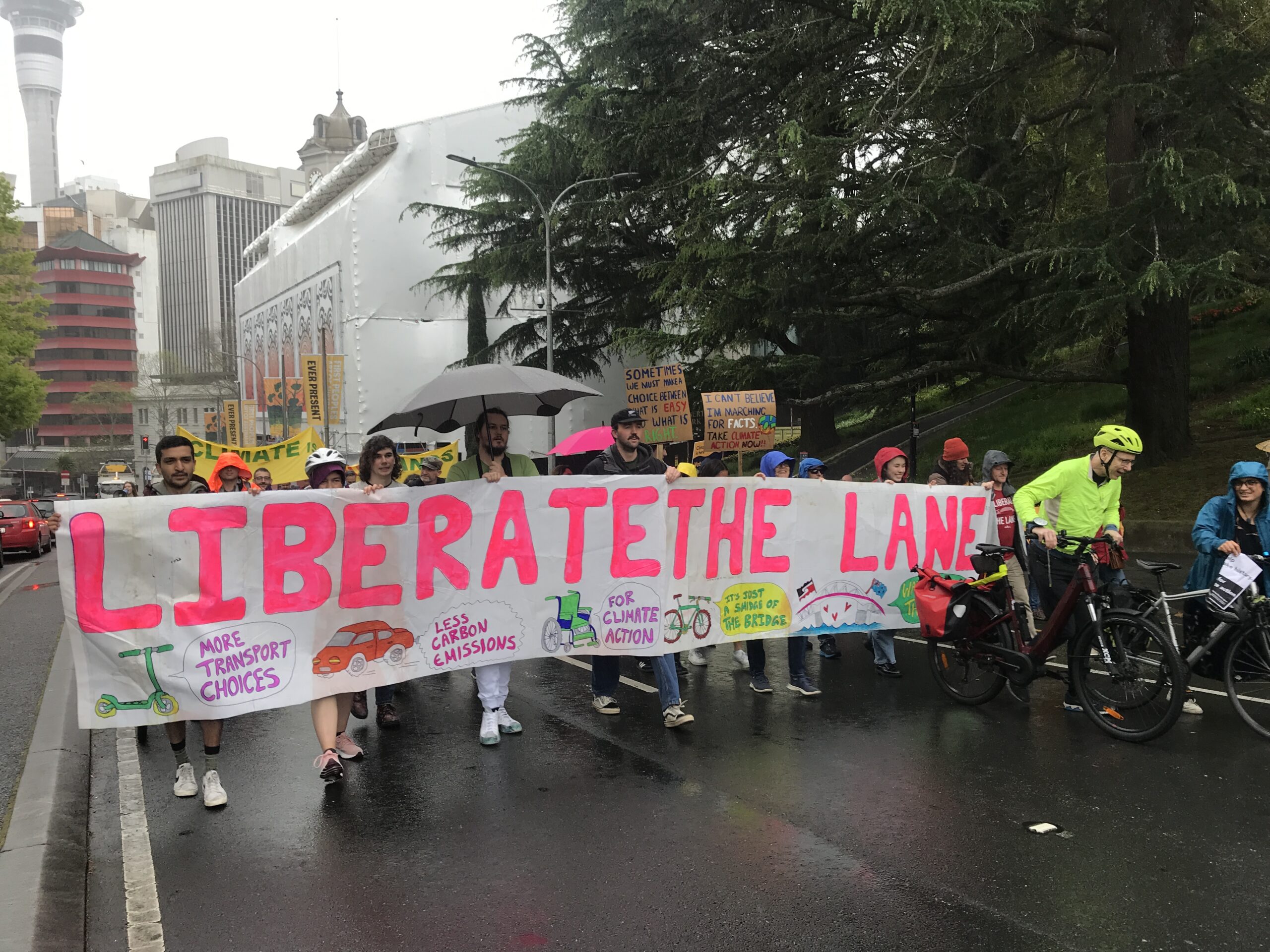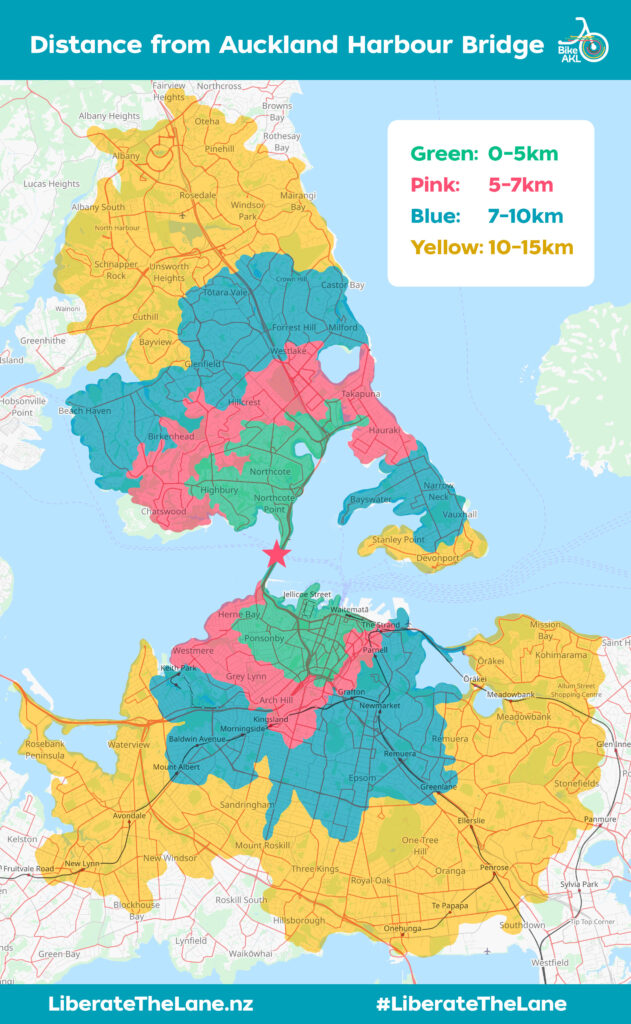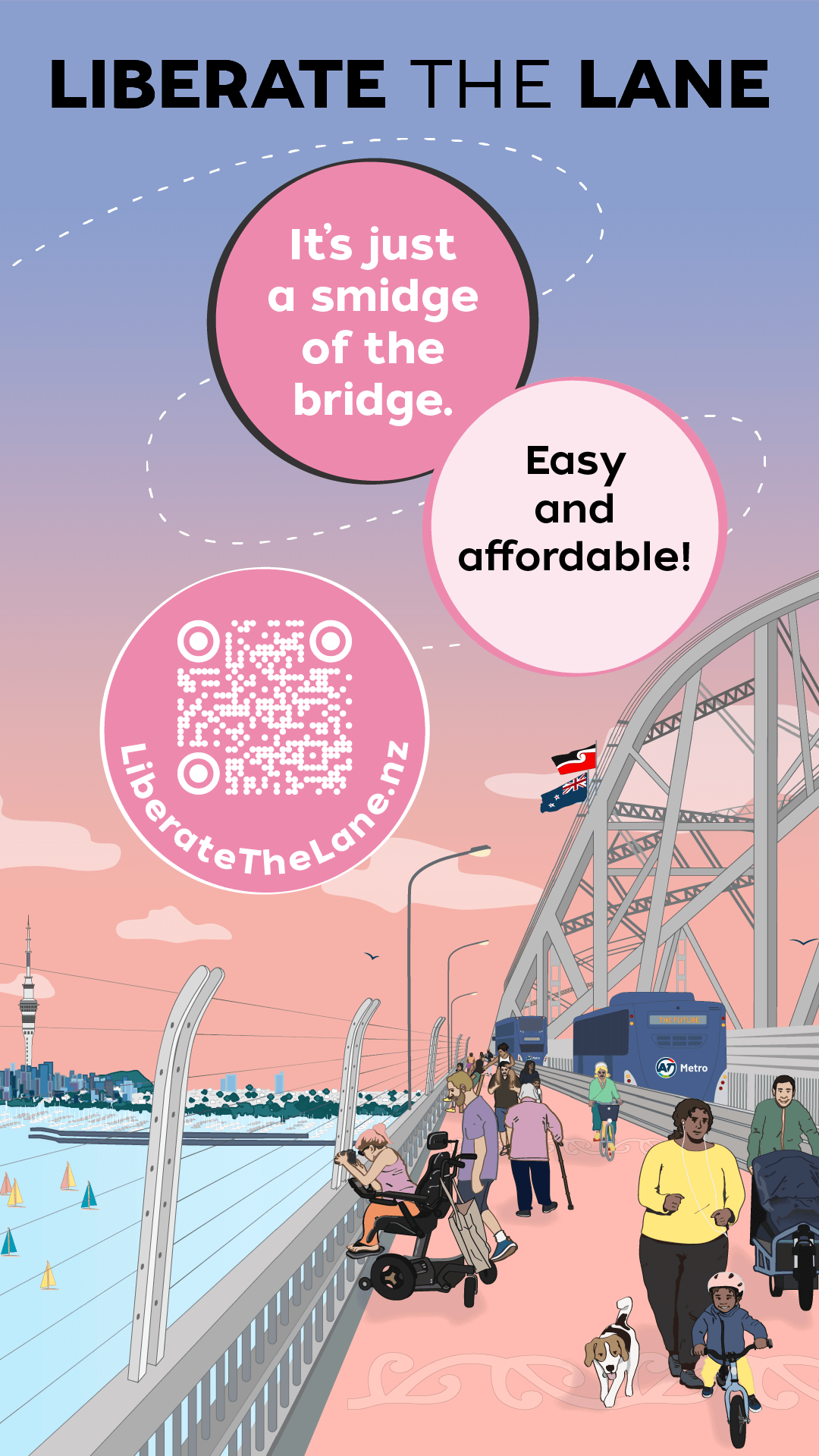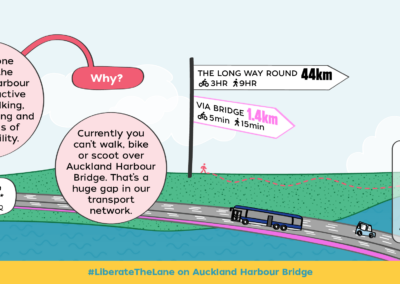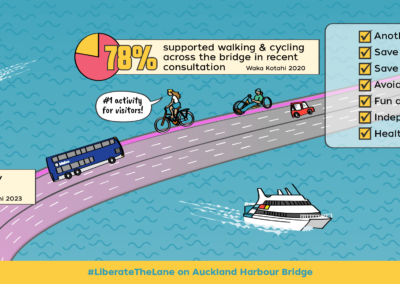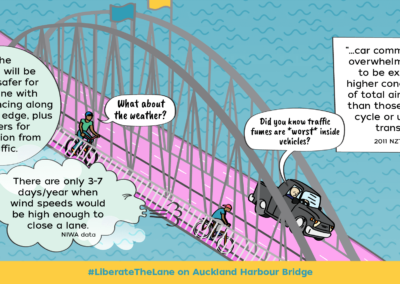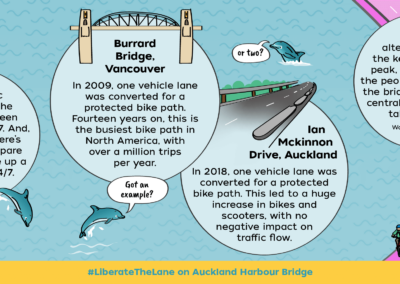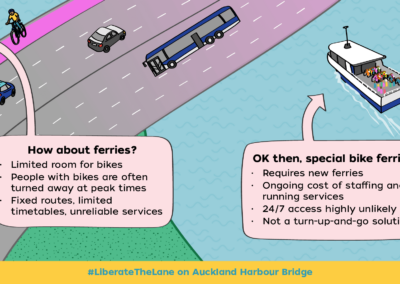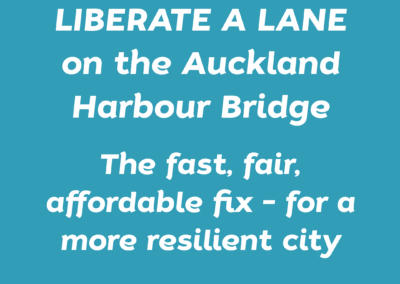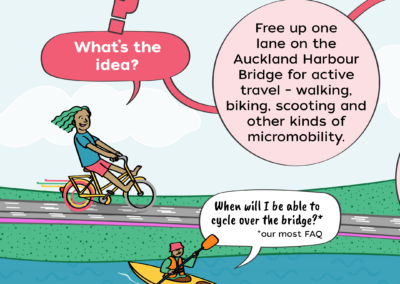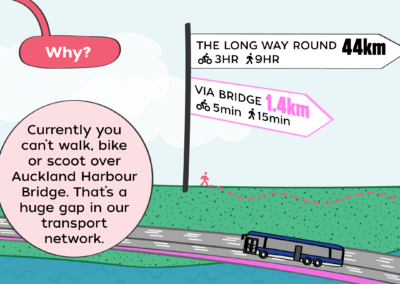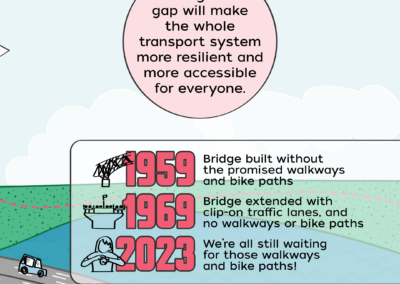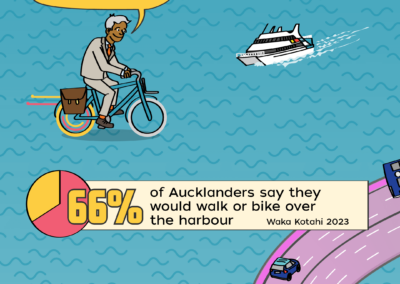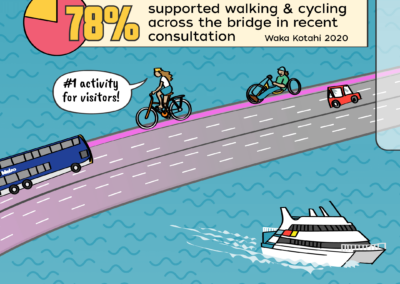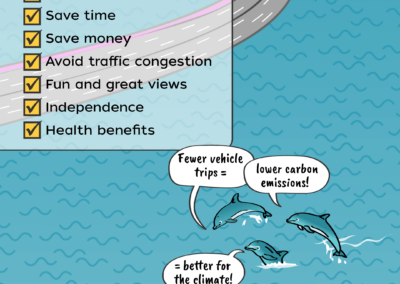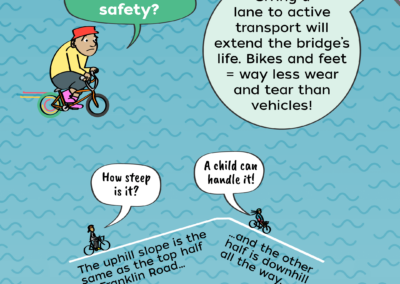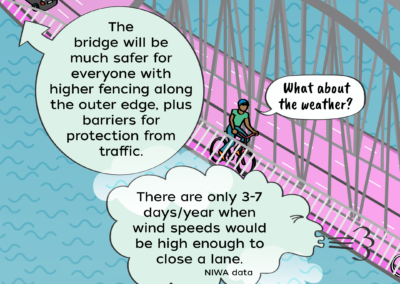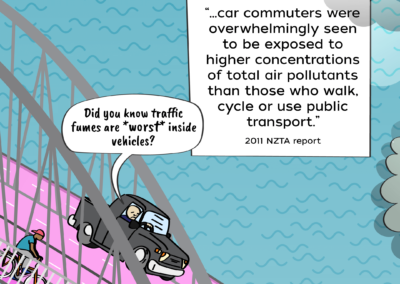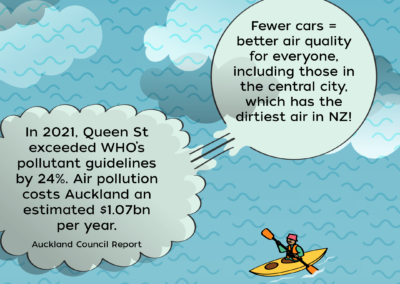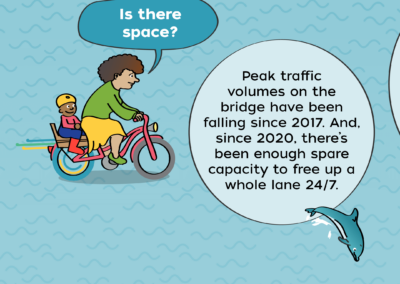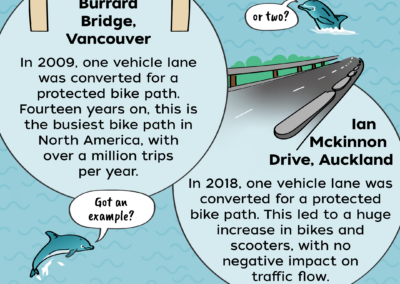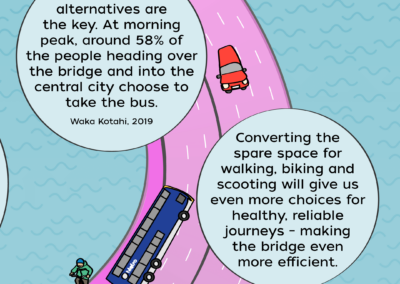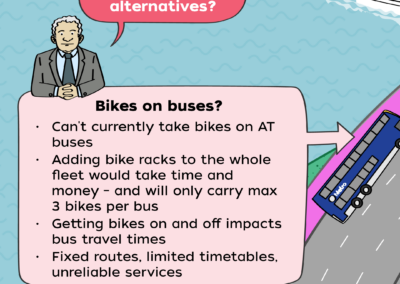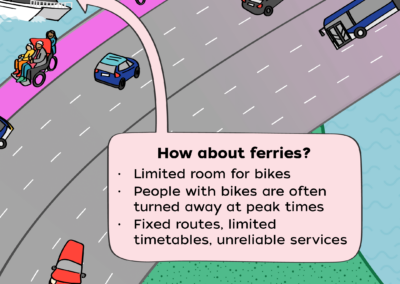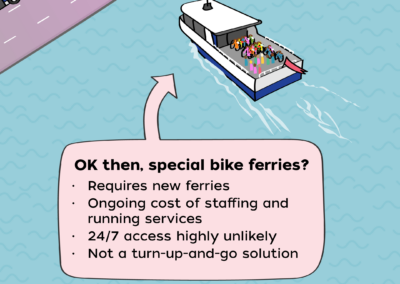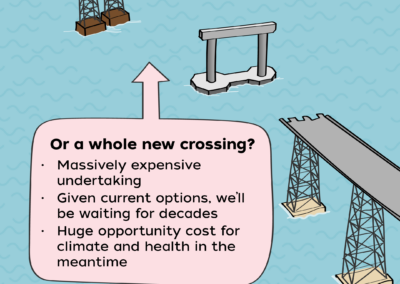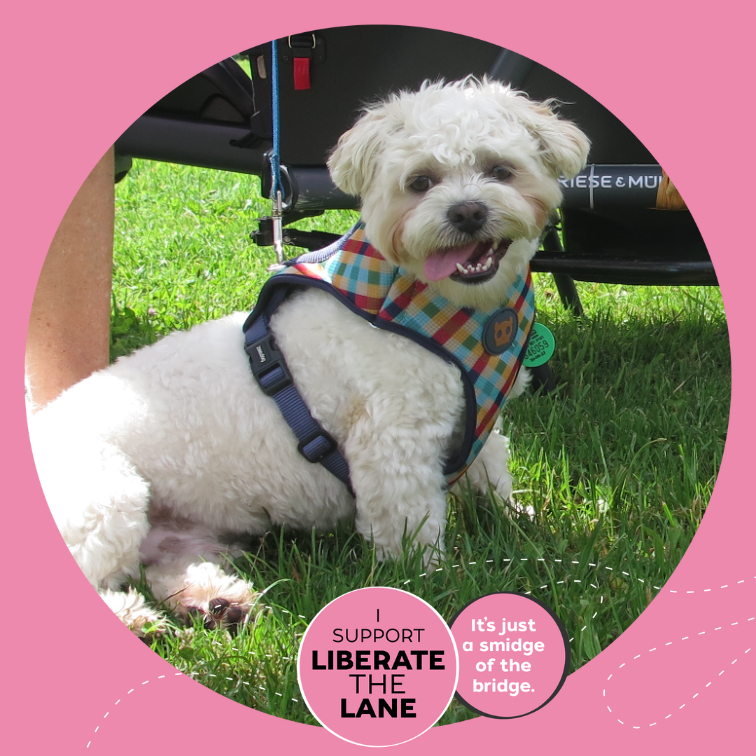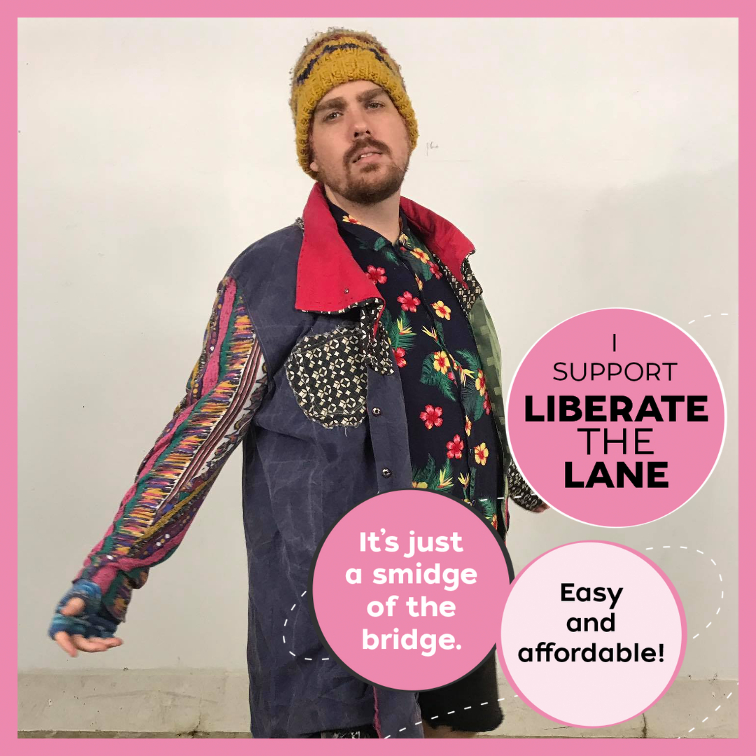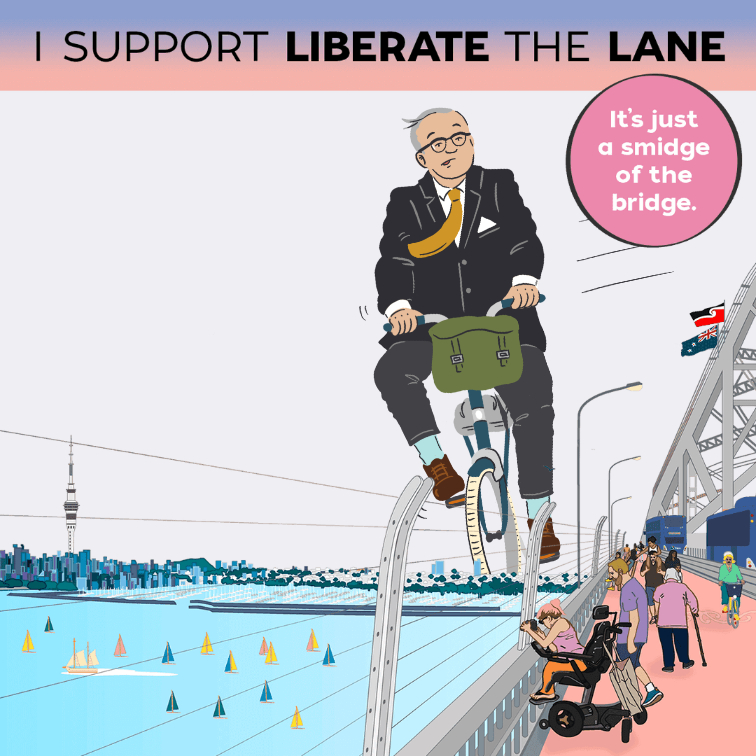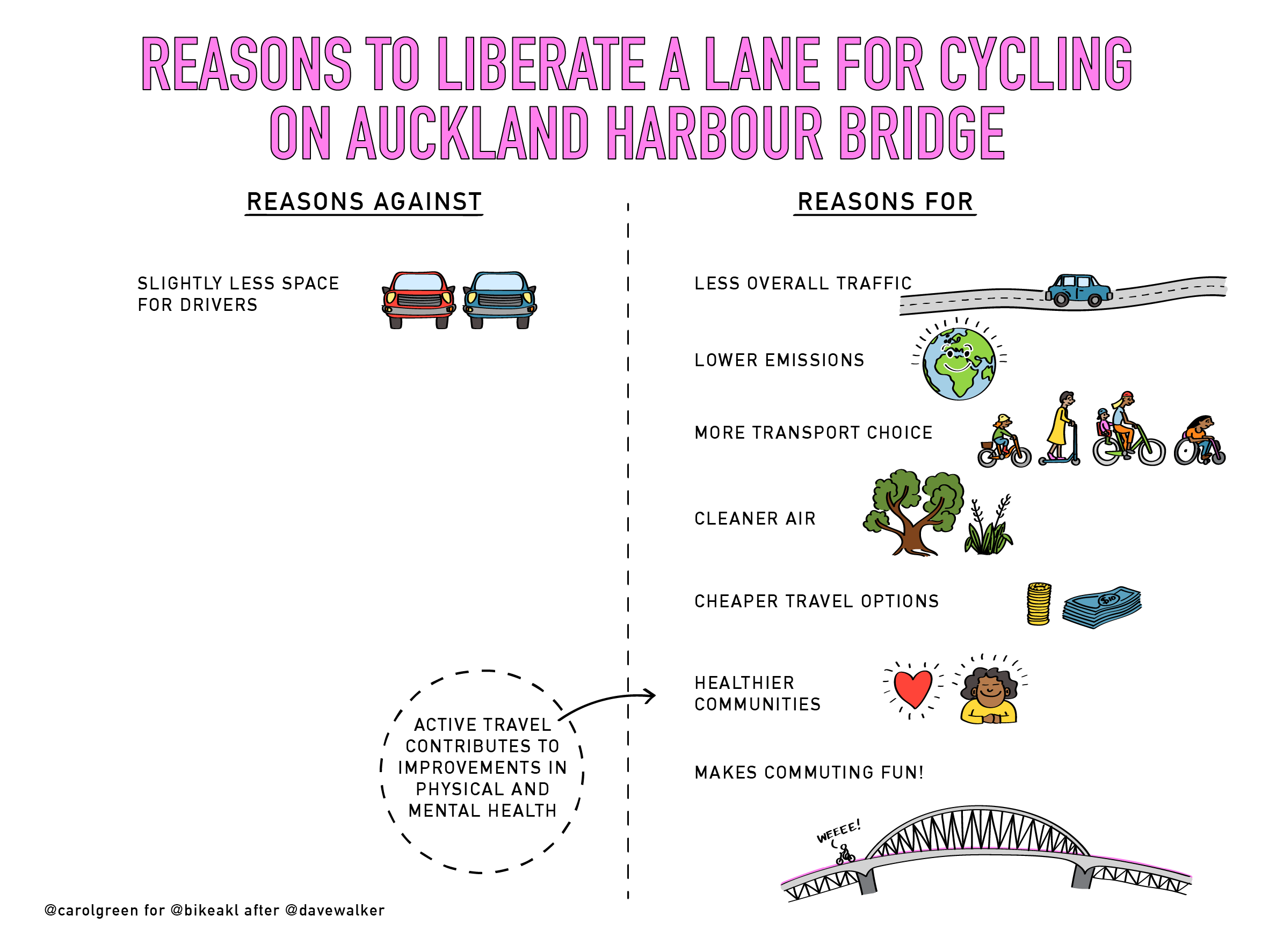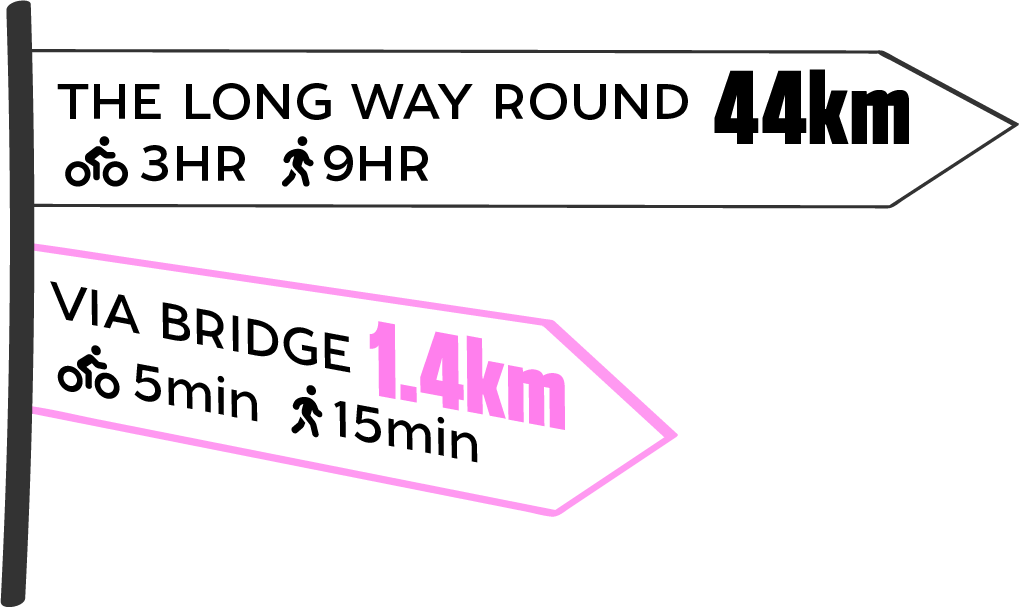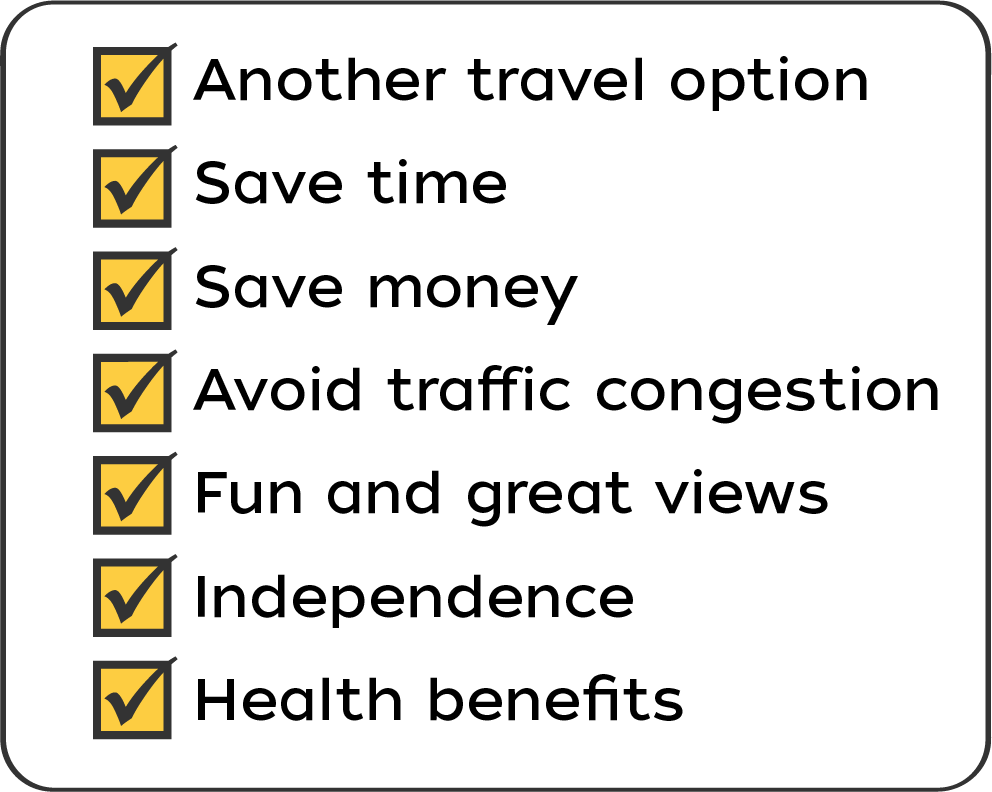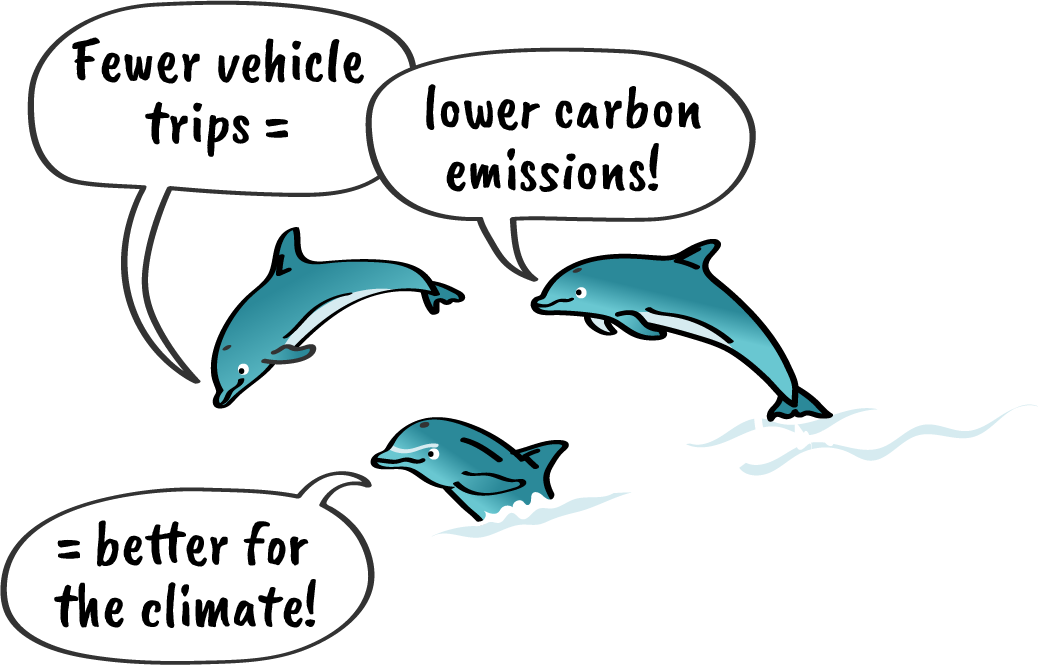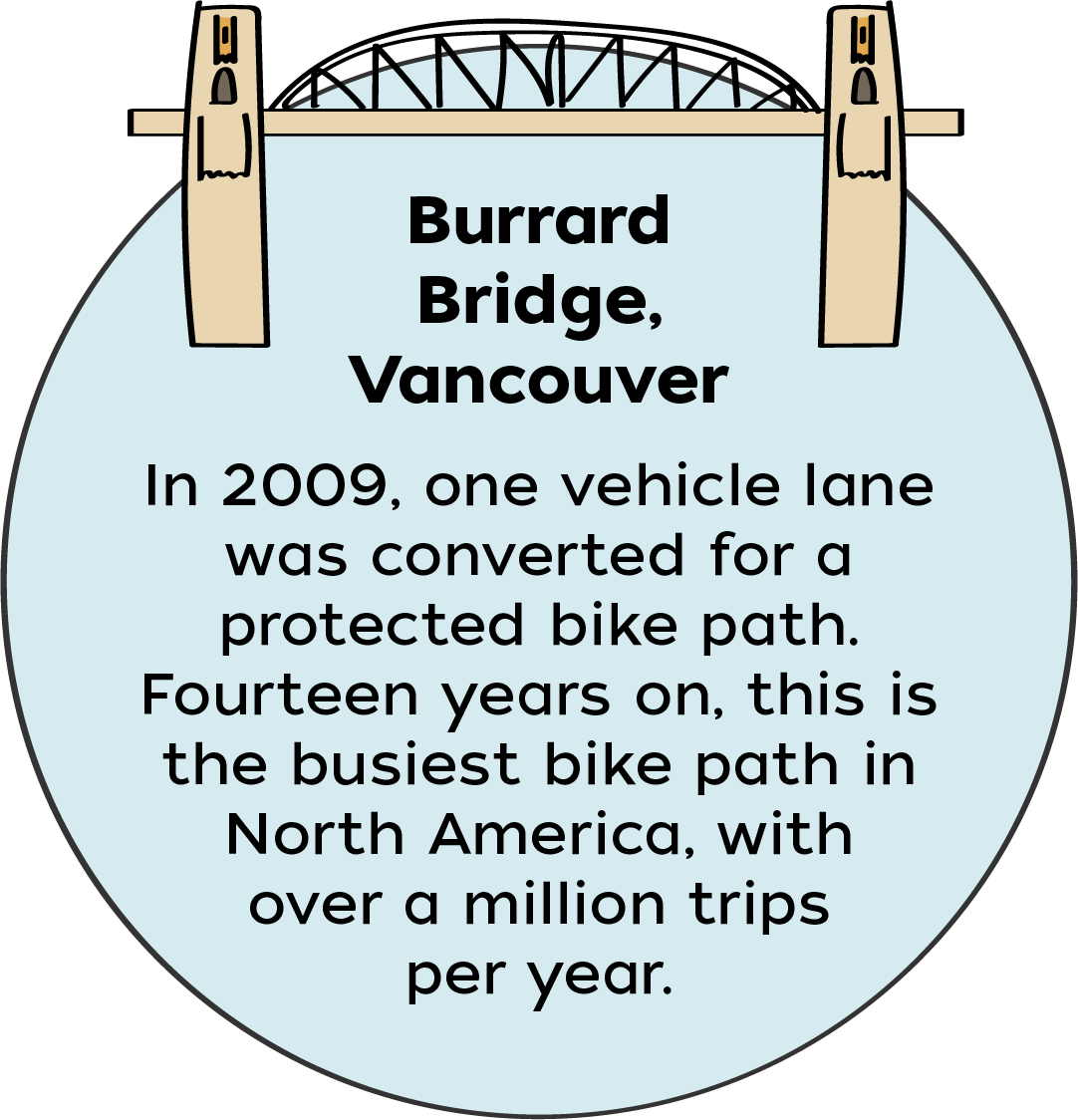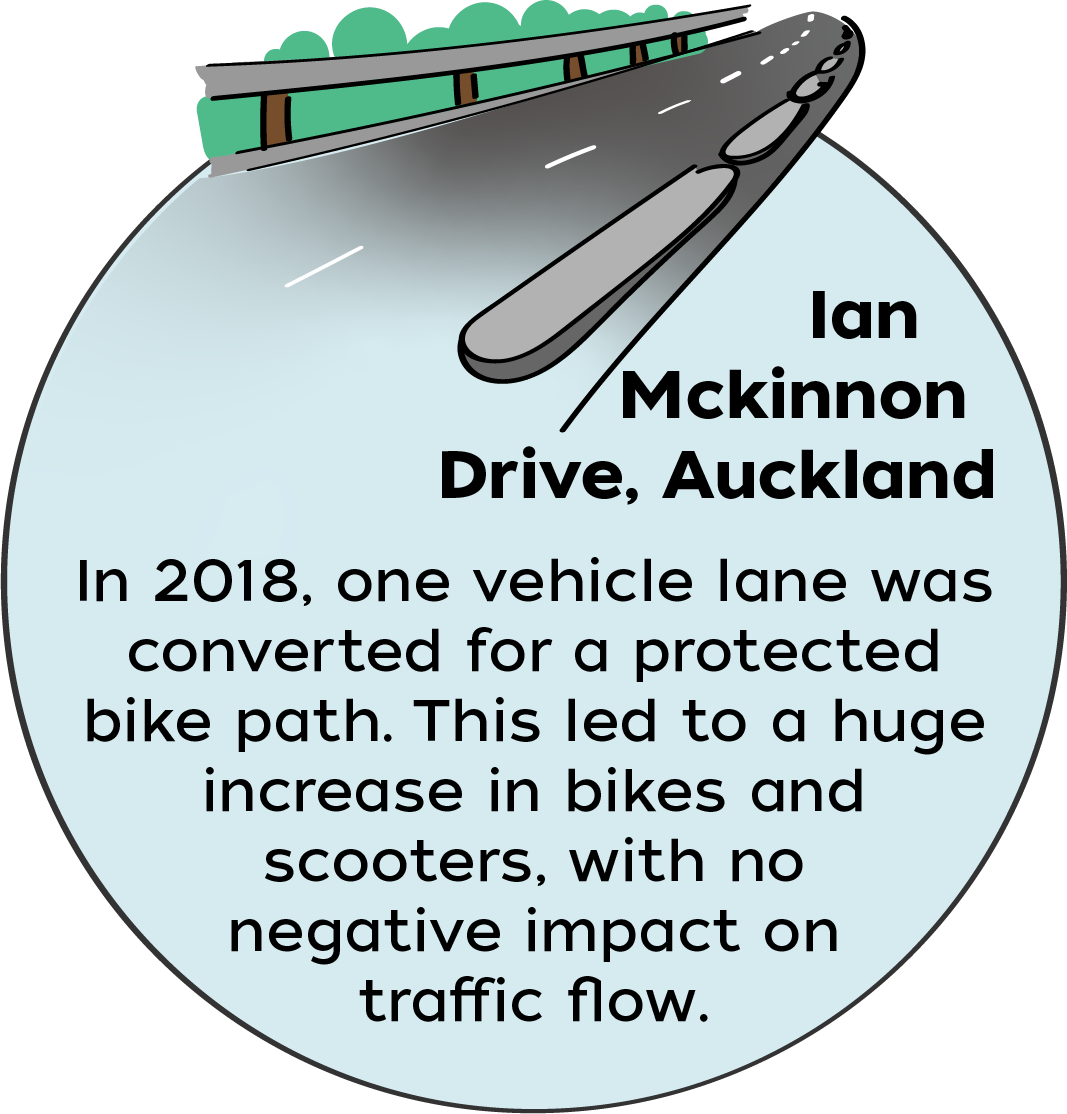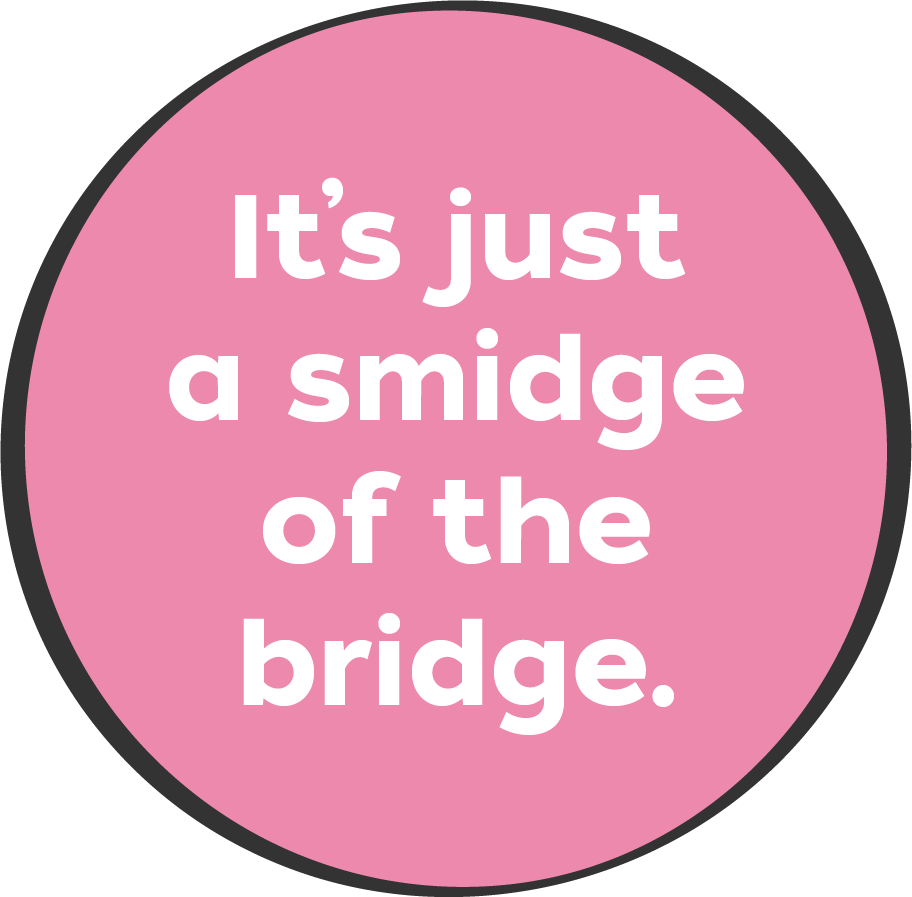Liberate the Lane
It’s just a smidge of the bridge!
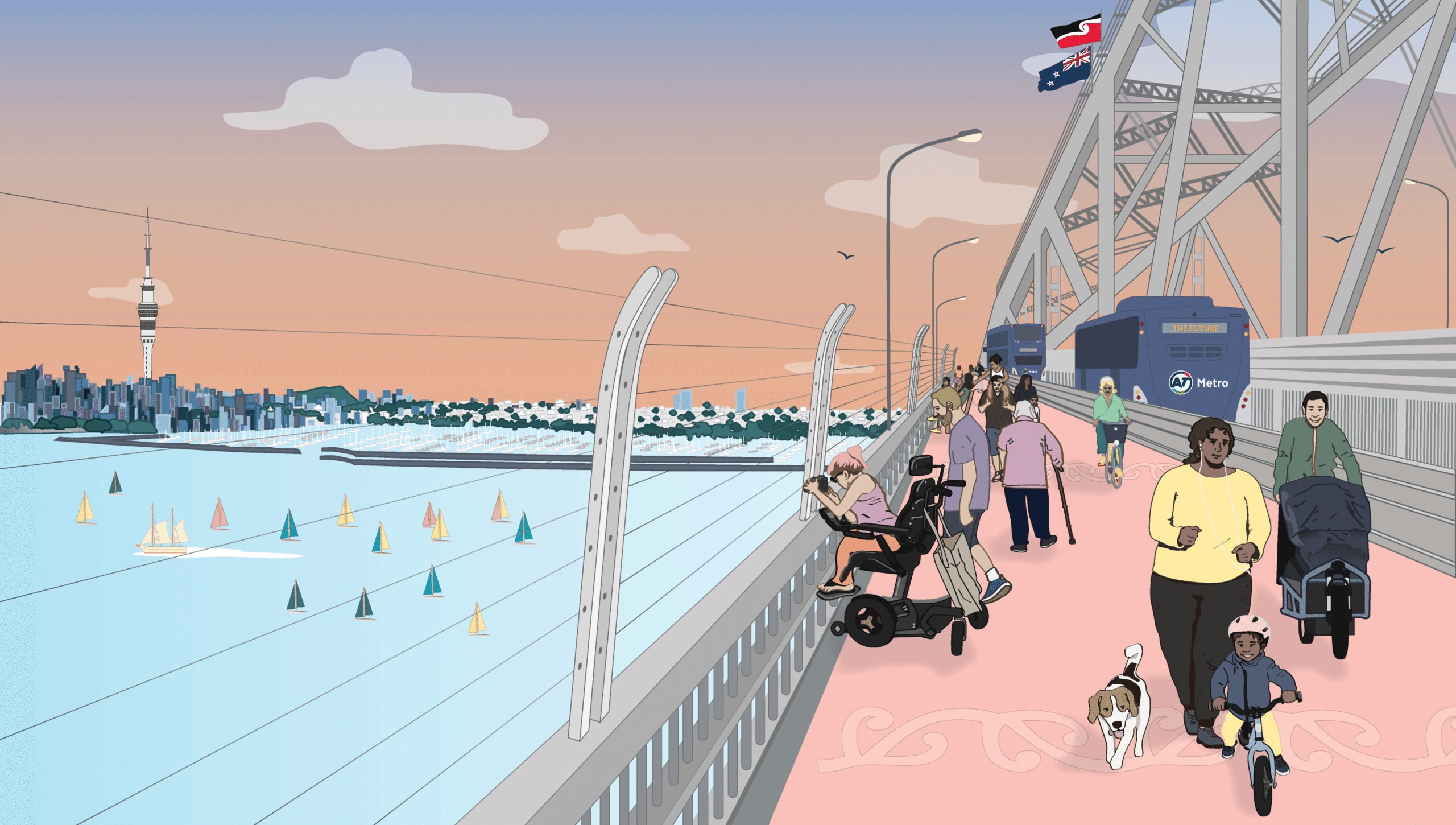
Our vision for a Tāmaki Makaurau Auckland for everybody
It’s 2026, and the Auckland Harbour Bridge is finally open to all modes of everyday transport.
Using a dedicated lane protected from traffic, people can now freely walk, scoot, cycle and roll across the Waitematā Harbour – saving time and money, and breathing in the stunning view of the city across the water.
Tourists pause and take photos, commuters in suits cycle and scoot by, and families are out walking and wheeling with their kids, going on a joyful adventure together. Bus passengers wave as they pass.
Everyone can now travel across the bridge in the way that they wish to, including for those who need or prefer to drive.
This is the Tāmaki Makaurau Auckland we dream of.
Help make this vision into reality by signing your organisation on to our open letter:
An open letter to Waka Kotahi NZTA
To: Nicole Rosie, CEO of Waka Kotahi NZTA; and
the Board members of Waka Kotahi NZTA
cc: Hon Chris Bishop, Minister for Transport; and
Hon Simeon Brown, Minister for Tāmaki Makaurau Auckland;
Wayne Brown, Mayor of Tāmaki Makaurau Auckland; and
Dean Kimpton, CEO of Auckland Transport
Tēnā koutou,
As the transport agency for Aotearoa New Zealand your primary function is “to create an affordable, integrated, safe, responsive and sustainable land transport system”. This means ensuring people are safe when they move around our country, providing accessibility and transport choice, and making it easier for people to choose sustainable transport modes.
Currently in Tāmaki Makaurau Auckland there is a glaring gap in our transport network: the Auckland Harbour Bridge, which connects the North Shore and the City Centre. The bridge does not provide for active modes: walking, cycling, mobility devices, micromobility. As such, the only way for active modes to travel between the North Shore and the City Centre is over 40 kilometres; all the way around the Harbour via Hobsonville Point. This takes roughly three hours on a bike, and at least eight hours on foot. For most people this is not a serious option for everyday transport. But, crossing Harbour Bridge would take only 5 minutes by bike and, on average, 15 minutes to walk.
The Climate Commission’s recent recommendation included completing cycle networks in main cities by 2030, i.e. within the next 7 years. Under current plans the missing link across the Waitematā won’t be connected for another 15 – 20 years, far beyond the 2030 target. We urge you to provide an interim solution for access now, by repurposing a lane on the existing Harbour Bridge for walking and cycling. This would be a powerful and effective symbol of a commitment to climate action.
Your own survey data confirms that Aucklanders want to get across; 78% supported walking and cycling in your 2020 consultation, and 66% said they would walk or cycle across the Harbour in your 2023 Waitematā crossings survey. Moreover you noted that “There was also strong support for cycling infrastructure sooner, rather than later, with comments suggesting a cycle lane on the current bridge”
Reallocating one lane on the existing Harbour Bridge towards active modes gives you the opportunity to increase the resilience of our transport system, provide for accessibility and transport choice, and make it easier for people to choose sustainable, healthy transport modes.
We ask you to free up one lane on the Auckland Harbour Bridge for walking, cycling, and micromobility. Doing so will…
✔ empower people to choose climate-friendly, active travel
✔ give more transport choice to people who don’t drive
✔ reduce the cost of travel for many
✔ create a more resilient transport system
✔ make more efficient use of our existing transport system
And, we know it can be done fast and affordably. We have confidence in your ability to deliver at pace.
Looking forward to seeing action from you on this soon.
Ngā mihi nui,
The organisations listed under
www.liberatethelane.nz/#supporters
We call on Waka Kotahi to free up one lane on the Auckland Harbour Bridge for walking and cycling, for a more resilient and connected transport network for people in Tāmaki Makaurau.

Place Creative
Check out their website here.
Read statement
Place Creative’s mission is to enable more people to participate and enjoy life in Tāmaki Makaurau, and too often transport is a major barrier to this. Waka Kotahi has the mandate to disrupt the status quo, be brave, and shift some space so that thousands more people can cross the bridge- and see their city from a whole new perspective.
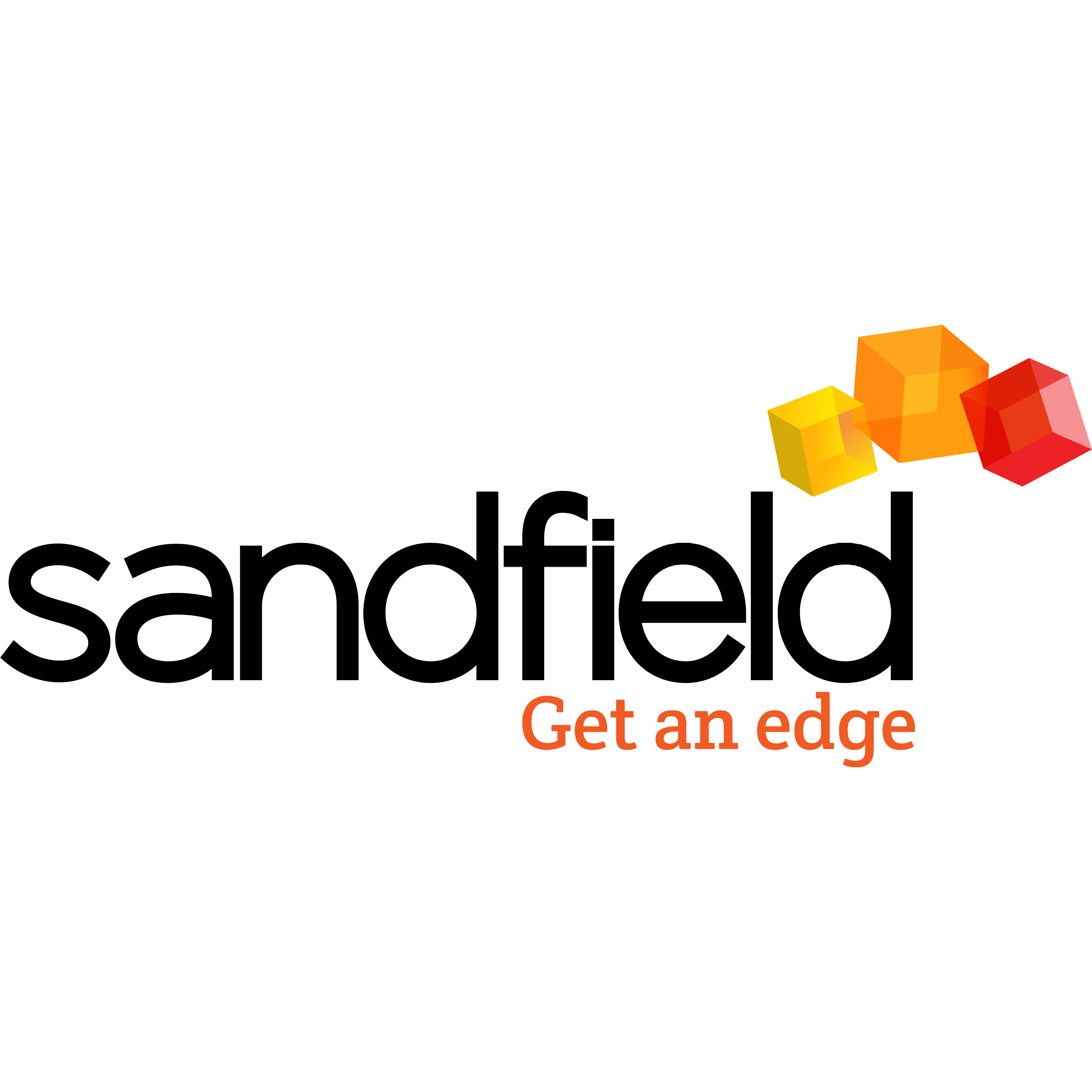
Sandfield Associates
Check out their website here.
Read statement
Our team can get jobs with world leading tech companies in any city they choose around the world. Talent is choosing cities with great public amenity and Auckland is woefully falling behind. Let’s do something bold and get people walking and riding bikes over the Harbour Bridge. Not in one or two decades time but in a couple of years.

SmartSense
Check out their website here.
Read statement
In preparing our Auckland Harbour Bridge reports for Bike Auckland, SmartSense have looked at the data, and concluded that allocating one lane for people to walk and cycle across the bridge is practical, inexpensive and safe. It is not without its challenges, but with a high degree of co-operation, some kiwi ingenuity and a ‘can-do’ approach, it would be possible to provide equitable access to all Aucklanders to cross the Waitematā harbour within a year.
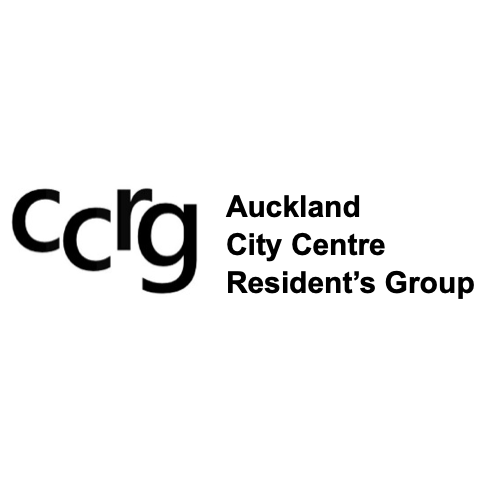
Auckland City Centre Resident's Group
Check out their website here.
Read statement
CCRG support initiatives like this that provide city centre residents (and others) with more options to move around, and in and out of the city centre. A majority of individuals here do not own private vehicles so this supports accessibility and choice, along with enabling the low carbon lifestyle that living in apartments can provide. It also supports healthy activity and creates opportunity for building community.

Cycling Action Network
Check out their website here.
Read statement
The race for a safe climate has begun. Liberating a Lane across Waitematā Harbour is an essential step towards our low-carbon future. Let’s respond to popular demand, and make it easy and attractive for people on bike, scooters and foot get across.

OraTaiao
Check out their website here.
Read statement
OraTaiao strongly support the urgent change for one lane to be provided for active transport on an ongoing basis, and would remind Waka Kotahi that the decisions they make to uphold a car-dominated transport system contribute to the deaths of thousands of people in New Zealand every year though road trauma, air pollution and enforced physical inactivity.
More about OraTaiao and why they support Liberate the Lane here.
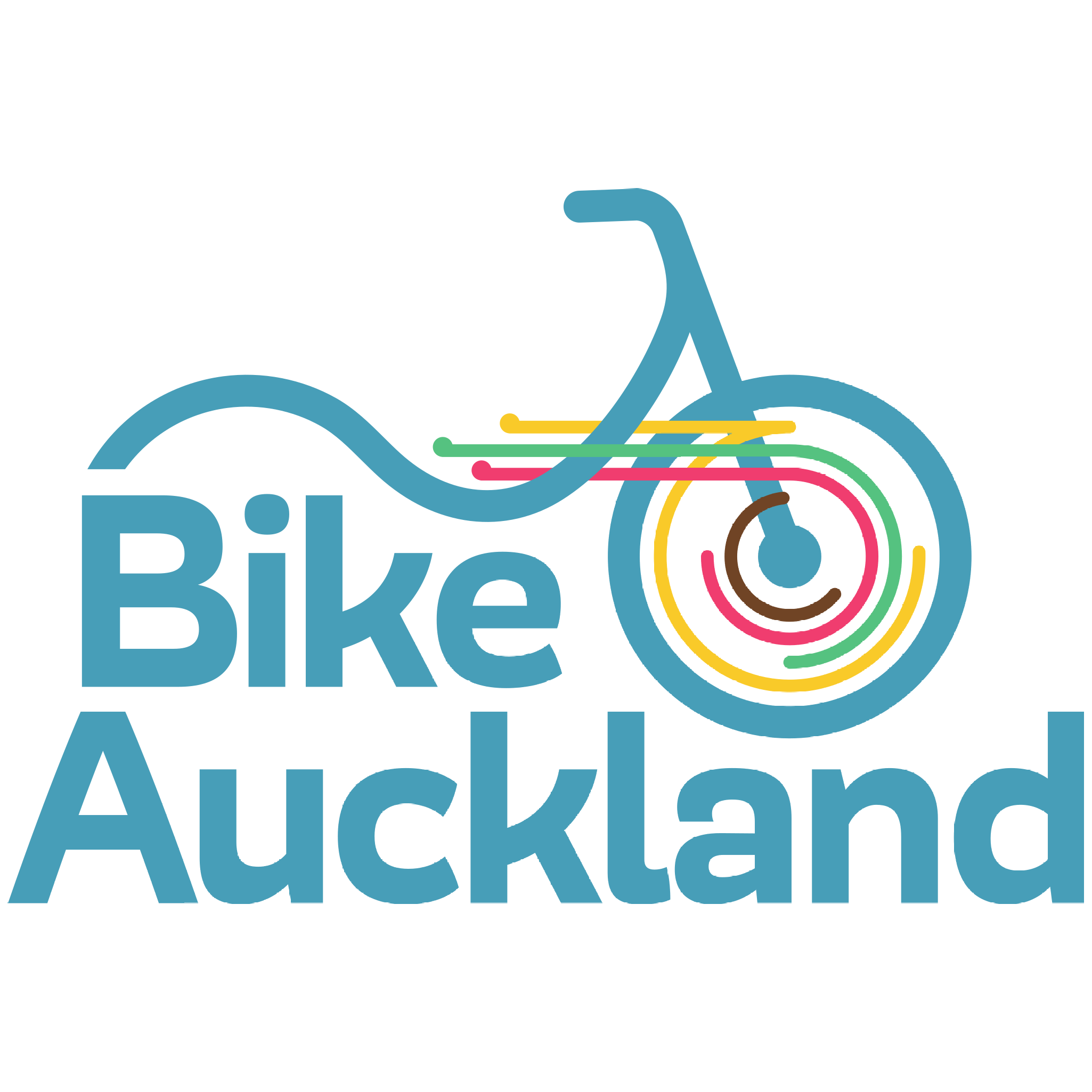
Bike Auckland
Check out their website here.
Read statement
To cross the Auckland Harbour Bridge we currently must be in a car, bus, truck or on a motorbike. A child can see it, and visitors to our city remark on it: this is a glaring gap in the heart of our transport system and a huge barrier to access and equity (especially for the more than 28% of Aucklanders* who don’t drive). Dedicating one lane to walking and cycling (and skating, and scootering…) on the Harbour Bridge will fix this injustice – and tackle a bunch of other urgent problems we face, from congestion to pollution, from accessibility to resilience.
Read more here.
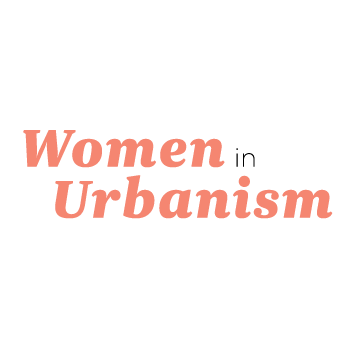
Women in Urbanism
Check out their website here.
Read statement
Our current car-centric transport system is inequitable. Women, older people, children and disabled people are underserved by it, yet are more likely to suffer from its negative effects, such as road harm and air pollution. We all want our neighbourhoods and cities to be healthy, safe and climate resilient. The harbour crossing needs to work for all of us, and liberating the lane would be an iconic step in the right direction.
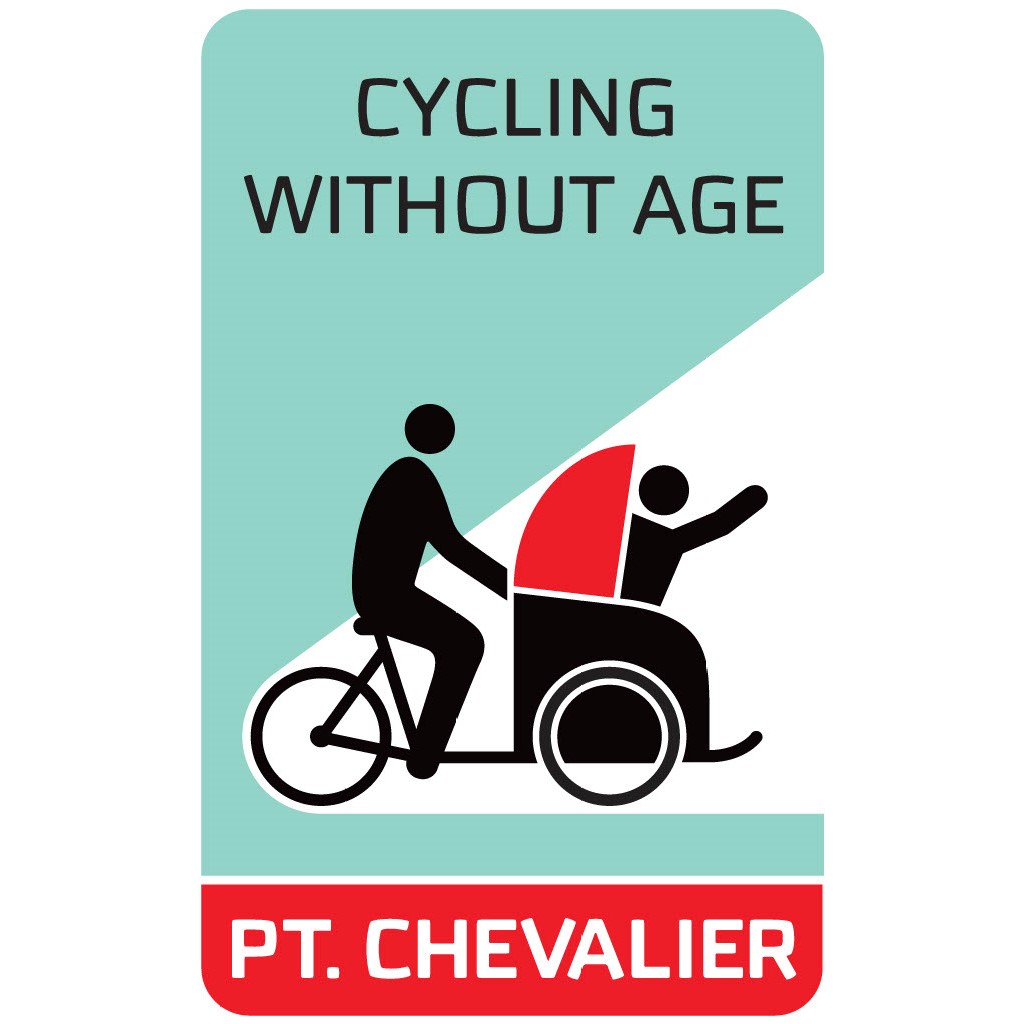
Cycling Without Age Pt Chevalier
Check out their Facebook page here.

mSupply Foundation
Check out their website here.
Read statement
The mSupply Foundation strongly supports the repurposing of an Auckland Harbour Bridge lane to enable our North Shore based staff to get to and from work in the CBD in a safe, healthy and efficient manner.
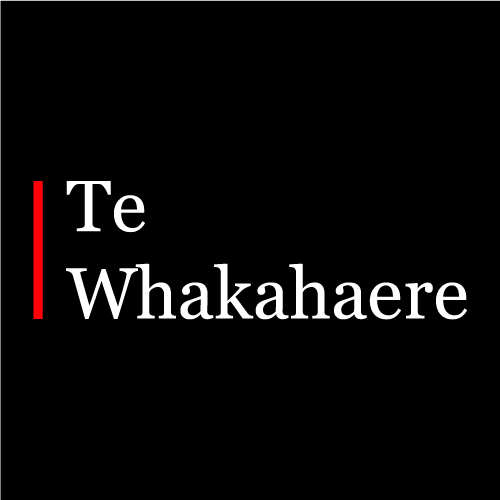
Te Whakahaere Āhuarangi Ltd
Check out their website here.
Read statement
We are all guardians of this planet; our actions have impact and can influence change. In a world, where climate change is certain, we have an opportunity, both individually and collectively, to have a positive impact on the health of the planet and the wellbeing of our communities.
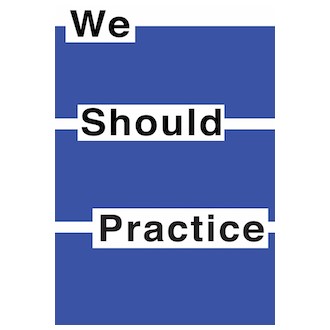
We Should Practice
Check out their website here.
Read statement
As an organisation, proudly based in South Auckland, the opportunity to traverse to the Northern side via bike would be transformative to say the least. We document our own and others art practices and have embraced again cycling as a mode to access these communities. Let’s extend the autonomy that motorists use over the Auckland Harbour Bridge with pedestrians and cyclists!
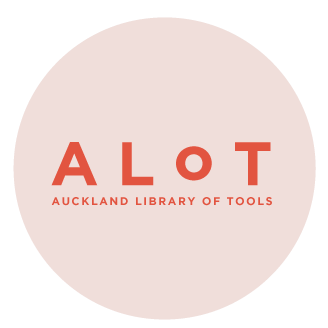
Auckland Library of Tools
Check out their website here.
Read statement
We have members and volunteers who commute from the North Shore to the Auckland Library of Tools via bike already, having to rely on irregular ferry times. We want our members to have the choice and freedom to cycle to Auckland Library of Tools.
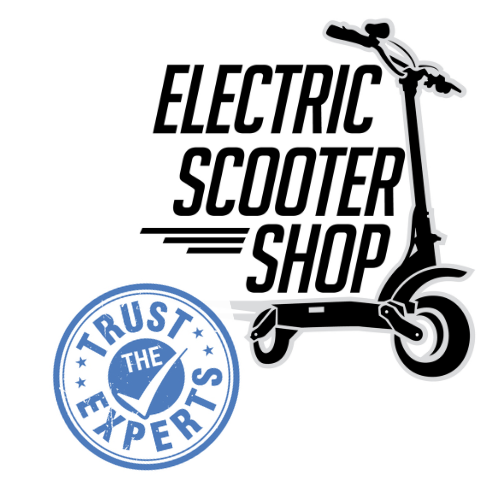
Electric Scooter Shop
Check out their website here.
Read statement
Connected networks are fundamental to success. Without this connection, an entire population base is isolated from the central city. Traditional transport is clogged and slow. Please free the people!
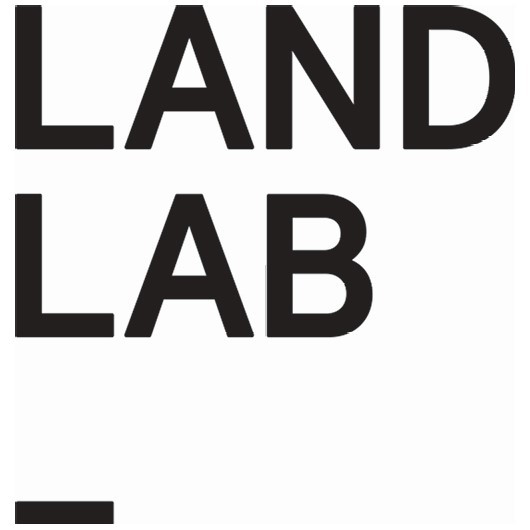
LandLAB
Check out our website here.
Red statement
LandLAB supports LiberateTheLane because its time we had a choice about how we cross the harbour, time we had a more resilient transport network and its beyond time we reduced emissions in accordance with our broader climate action commitments.

Climate Club NZ
Check out their website here.
Read statement
Transport emissions make up almost half the emissions in our largest city. Shifting to clean modes of transport is really important – and will mean safer, less polluted living spaces too!

Electric Bike Team
Check out their website here.

Nomad8
Check out their website here.
Read statement
Biking across Auckland is the best way to get from A to B. For our people to reach their clients across the bridge (in either direction) by bike would be the best outcome ever! Healthier for people and planet, less time spent sitting in traffic, lower travel costs, so many benefits. Yes please.
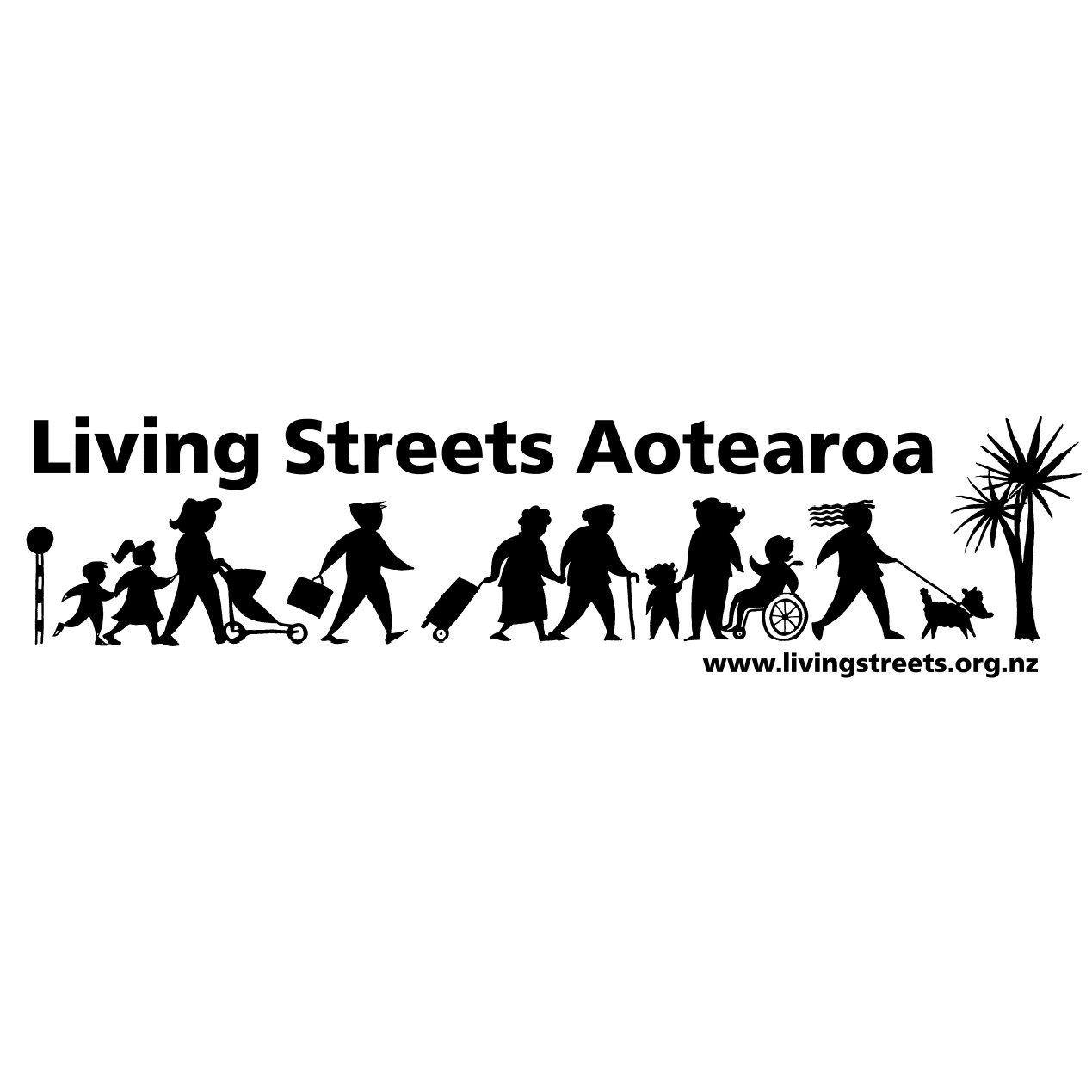
Living Streets Aotearoa
Check out their website here.
Read statement
A more walkable city is a better city. Living Streets Aotearoa believes that providing a lane for pedestrians and cyclists is equitable, sensible, safe and necessary. Let’s liberate the lane.

Sunset Road Family Doctors
Check out their website here.
Read statement
Walking and cycling is great exercise, and it would be great for people to have the option of cycle over the bridge.
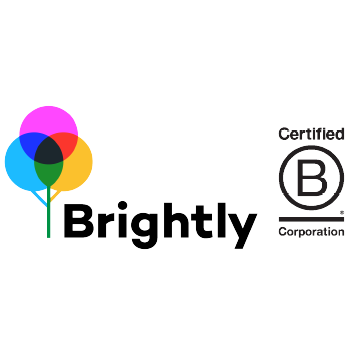
Brightly
Check out their website here.

SLABS
Check out their website here.
Read statement
As an avid cyclist and daily commuter, I’m happy to support initiatives that enable safe travel around our city by bike.

Katabolt Ltd
Check out their website here.
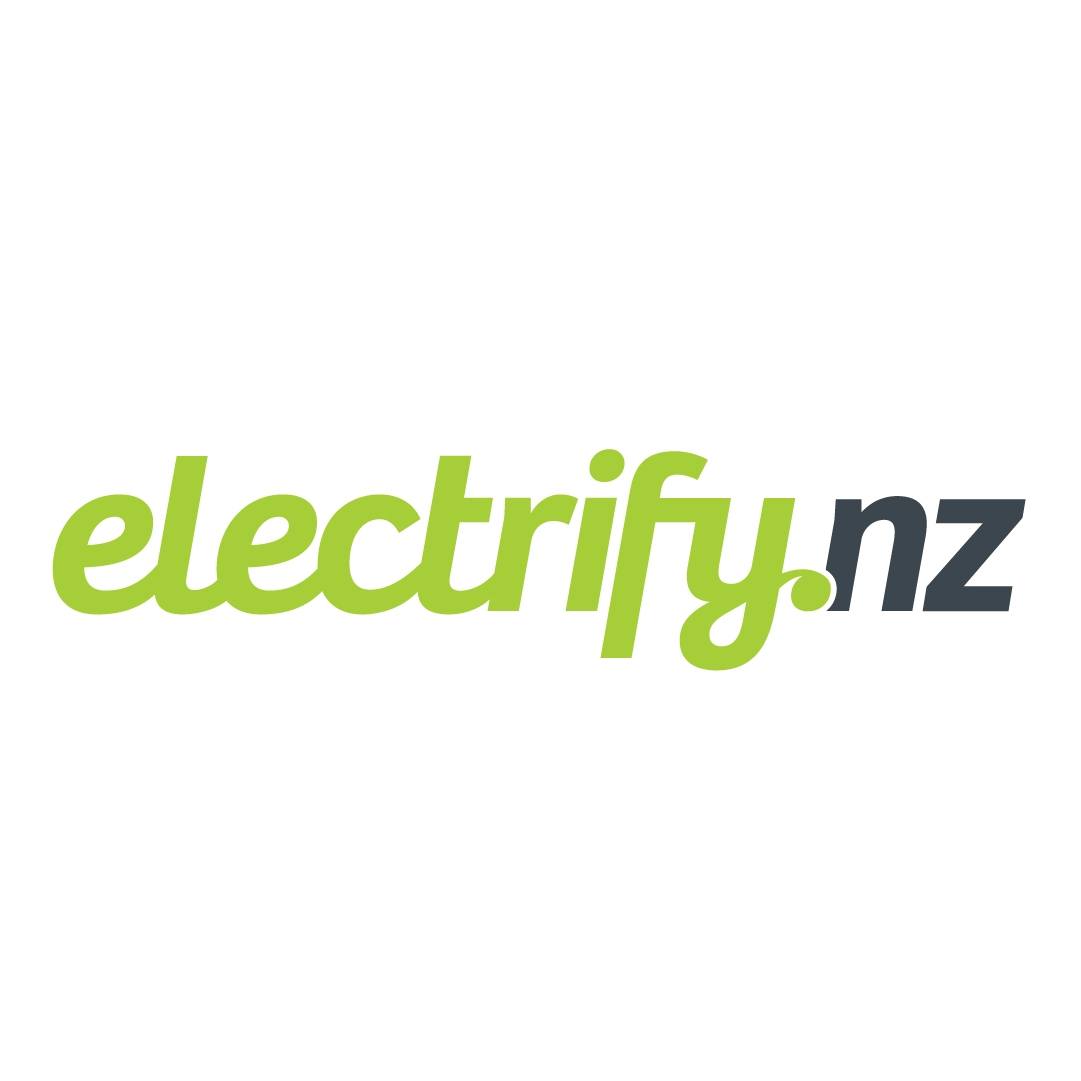
Electrify NZ
Check out their website here.
Read statement
Distance, hills, a sweaty commute to work. All those barriers go away with an e-bike and New Zealanders have cottoned on to that. Cycle lanes in urban areas are critical so that everyone from children through to older members of society can actually feel safe. Once it’s safe, cycling can potentially become the dominant form of transport and we can enjoy a lower emission, more physically active transport sector.

Lance McCaughan Photography
Read statement
While I do not live in Auckland, I have been cycling for 50 years and think it is about time cycles were allowed where cars are if you want people to use them as a transport option.
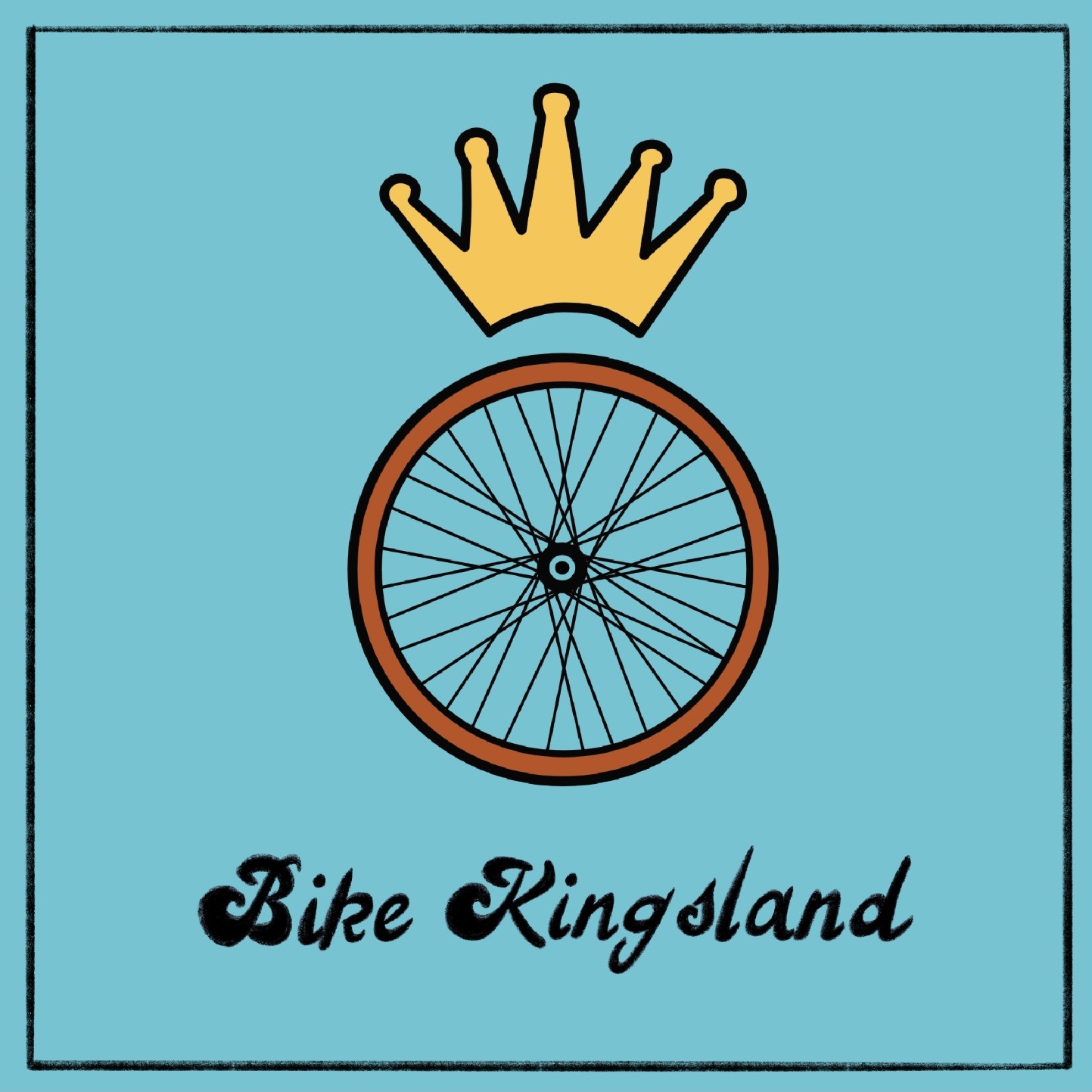
Bike Kingsland
Check out their Facebook here.
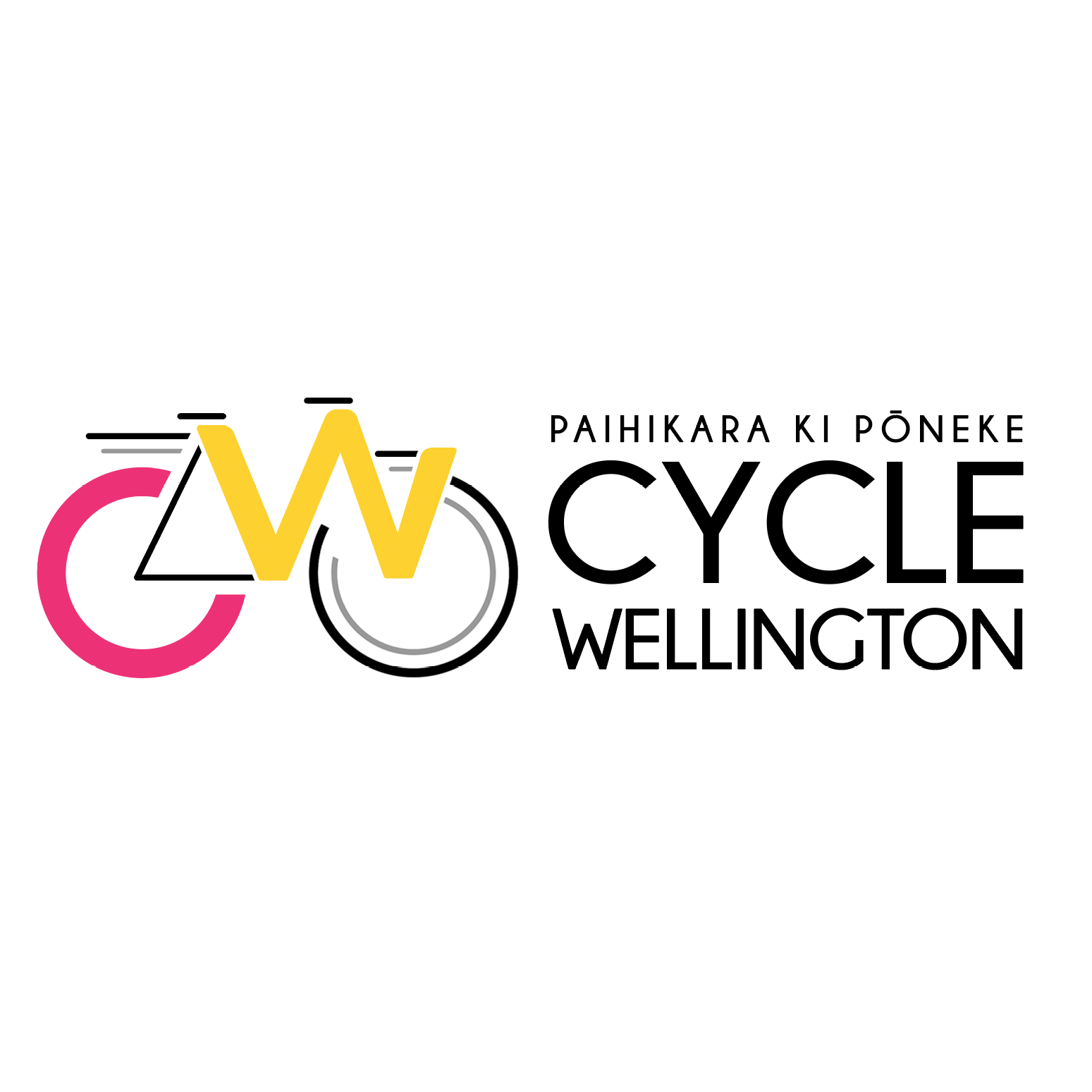
Cycle Wellington
Check out their website here.
Read statement
Great facilities enabling people to walk or cycle for everyday journeys is critical for helping reduce carbon emissions and congestion, addressing the cost of living, improving health outcomes, and more. We agree that reallocating one traffic lane on Auckland’s Harbour Bridge for people on foot or bike will benefit all of New Zealand, and is far, far past due. We need our transport system to better use public spaces we already have as we create cities for people.

Beam Mobility
Check out their website here.
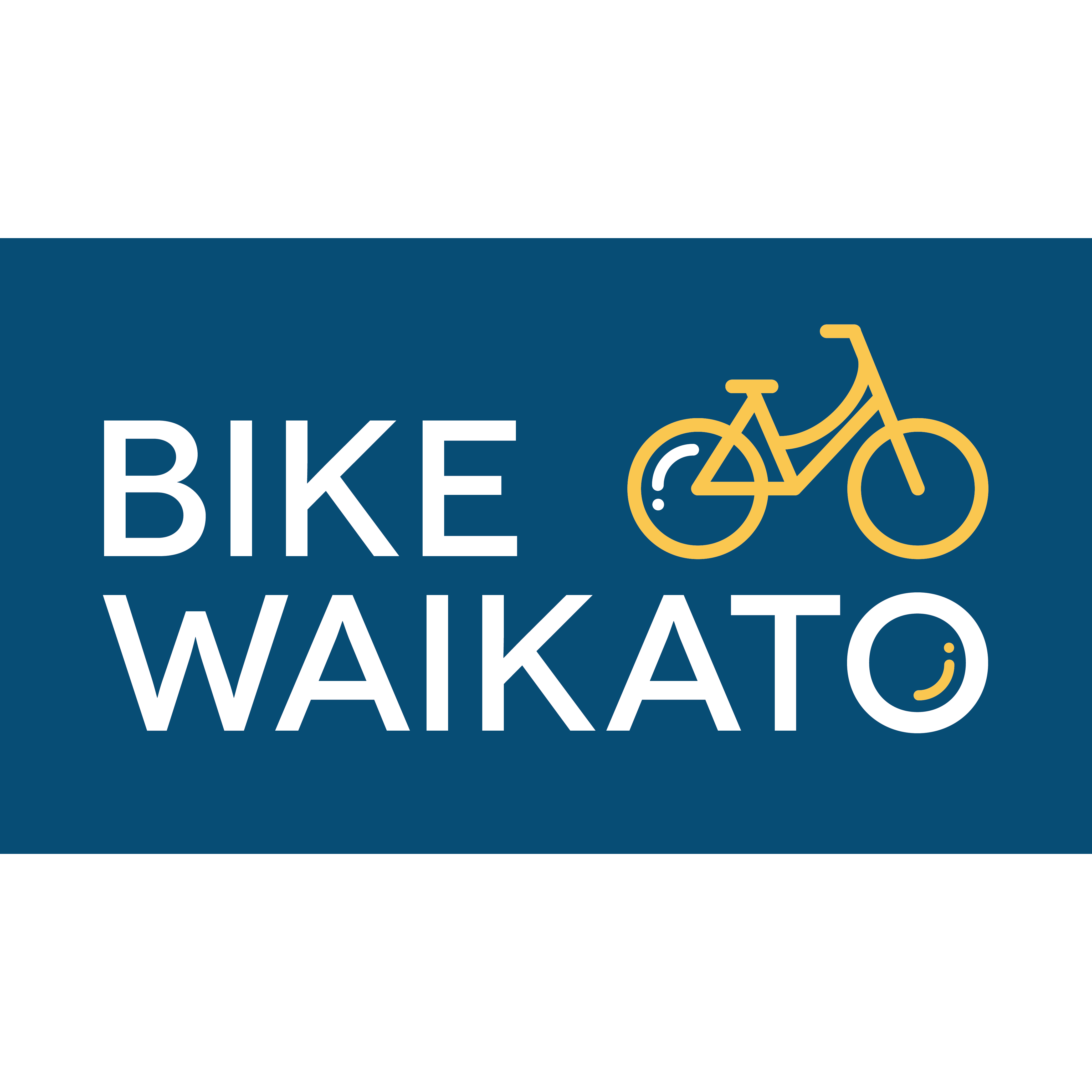
Bike Waikato
Check out their website here.

All Aboard Aotearoa
Check out their website here.
Read statement
All Aboard Aotearoa urges Waka Kotahi to Liberate the Lane, to rapidly connect Aucklanders over the harbour. It demonstrates how using our assets more efficiently leads to better transport choice. And best of all, it’s affordable.

Totara orthodontists
Check out their website here.
Read statement
We look after young people and want to help them live in a healthy world

Proxima
Check out their website here.
Read statement
Connecting a healthier, greener future – we support the cycling and walking lane on the Harbour Bridge.
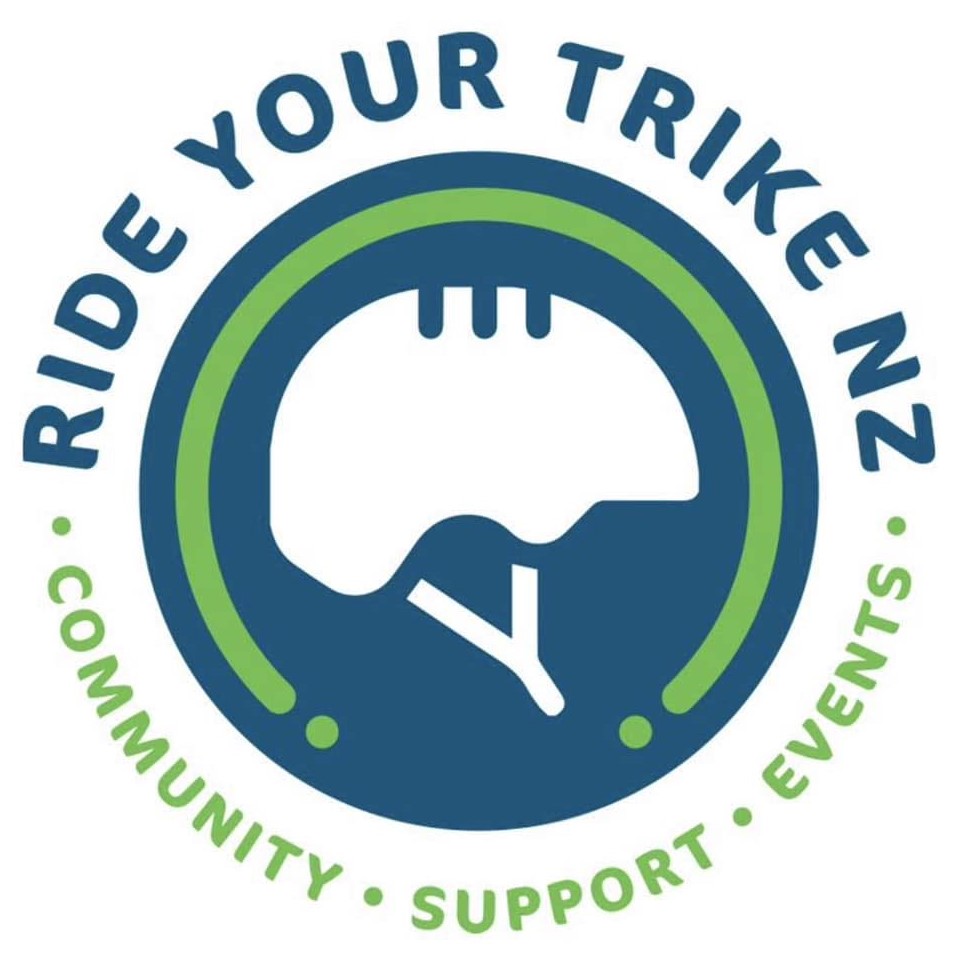
Ride your trike nz
Check out their website here.
Read statement
Ride your trike supports this as we advocate for better accessibility and mobility around nz
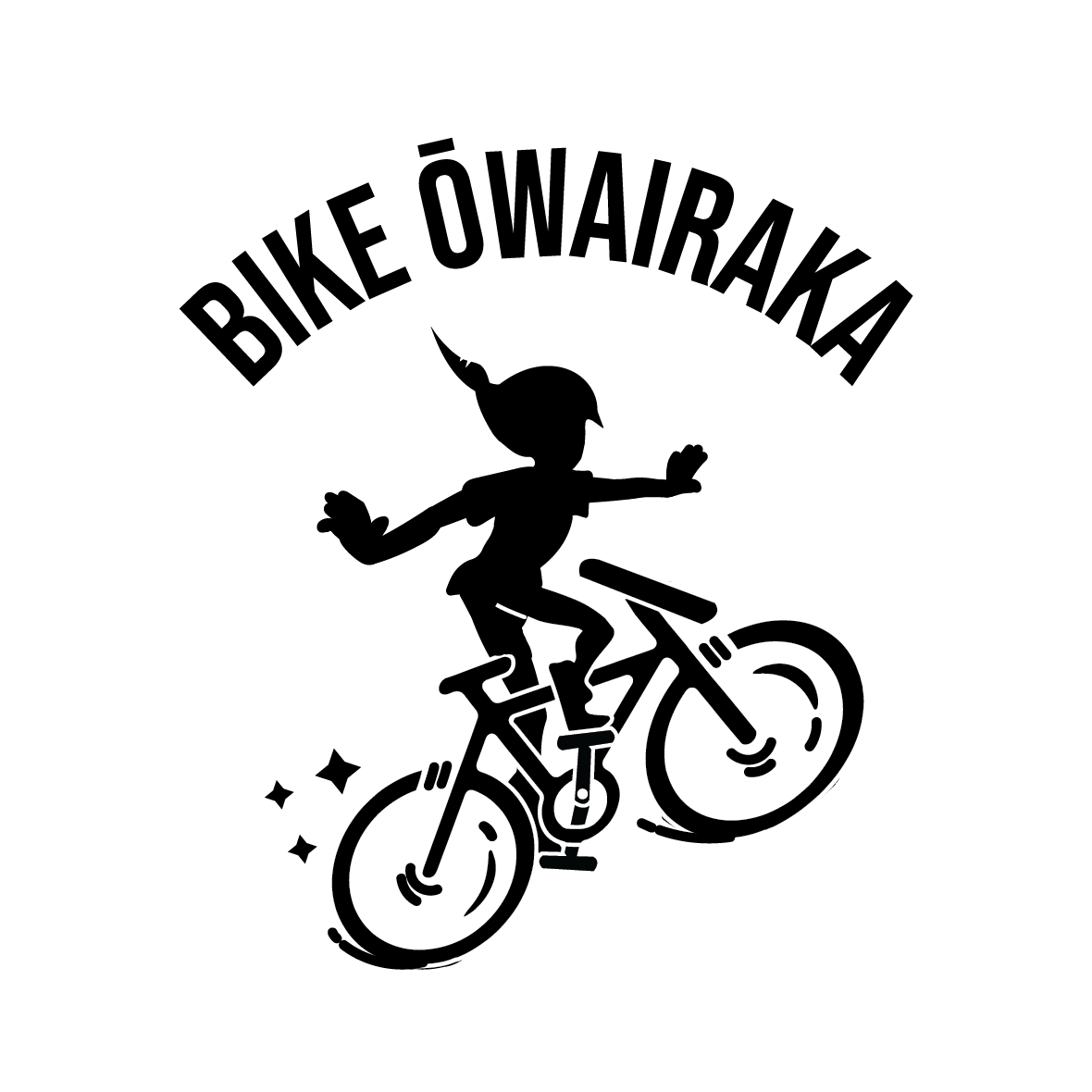
Bike Ōwairaka
Check out their Facebook group here.
Read statement
Bike Ōwairaka is a huge supporter of active mode travel on the Auckland Harbour Bridge. We want to get across by foot and on bikes/scooters/wheels etc. so that we can mitigate climate change, increase our health & well-being, decrease the cost of living, solve congestion, plus it’s lots of fun and a drawcard for visitors/tourists!
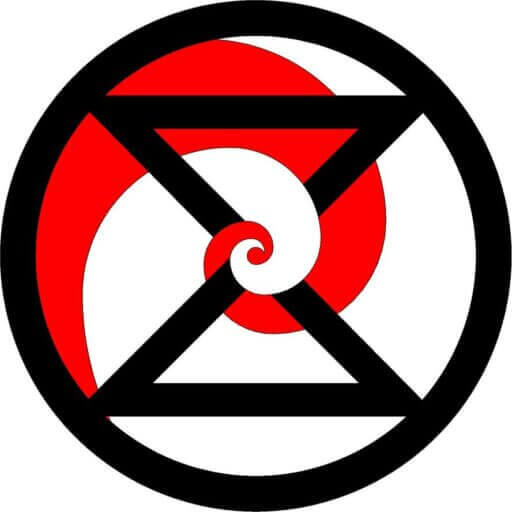
Extinction Rebellion Tāmaki Makaurau
Check out their website here.
Read statement
Transport is a large carbon emitter in our city. It is urgent that we create transport options giving more options than private motor transport. We need more options for micro-transport (small wheels) and pedestrians. This is essential as part of moving to the post carbon society.
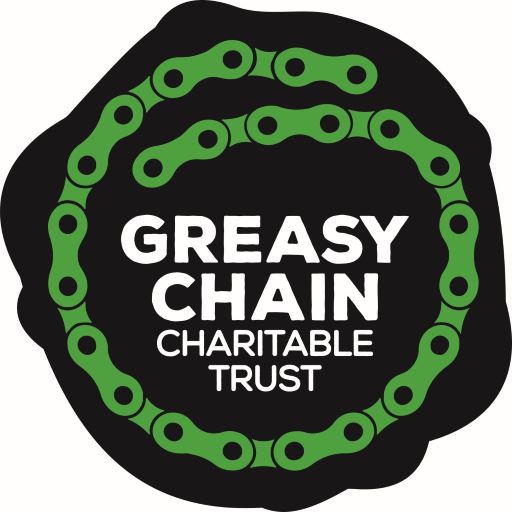
Greasy Chain Charitable Trust
Check out their website here.
Read statement
The Greasy Chain Cycling events and activities were borne of a passion for cycling in the Manawatū as a way to:
1. Improve public health (particularly the reduction of obesity and type two diabetes) through regular, healthy, outdoor exercise.
2. Reduce the current levels of increasing work-related stress in today’s work environment.
3. Provide greater independence for people, particularly older people unable to drive.
4. Over time, increase the amount of urban cycle trips taken by the public and thus reduce noise and carbon emission pollution.
5. For the Gravel & Tar Classic and La Femme to become “cannot miss” events on the UCI calendar for elite riders, and for the Slicks and Stones to become a “must do” for keen amateur cyclists.
Liberate the lane fits our principles and therefore we support this initiatives.
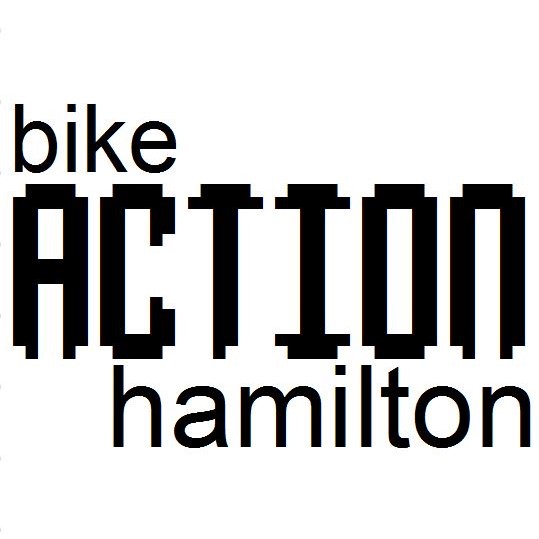
Bike ACTION Hamilton
Check out their website here.
Read statement
Safe and accessible cycling infrastructure is vital in all cities and towns in Aotearoa New Zealand. Reallocating a lane on Auckland’s Harbour Bridge will benefit everyone, help with reducing carbon emissions and reducing congestion. This should have happened decades ago. There is no reason not to allow people walking and biking to cross on the Harbour Bridge.

Benny's Bike Shop
Check out their website here.
Read statement
Far too long we have been car-centric in our thinking, time for a change as it’s not working. Bring on the tourists and regular folk who would love not to drive this piece of public road.

Revolution Insurance
Check out their website here.
Read statement
More cycling = less traffic = better Auckland!
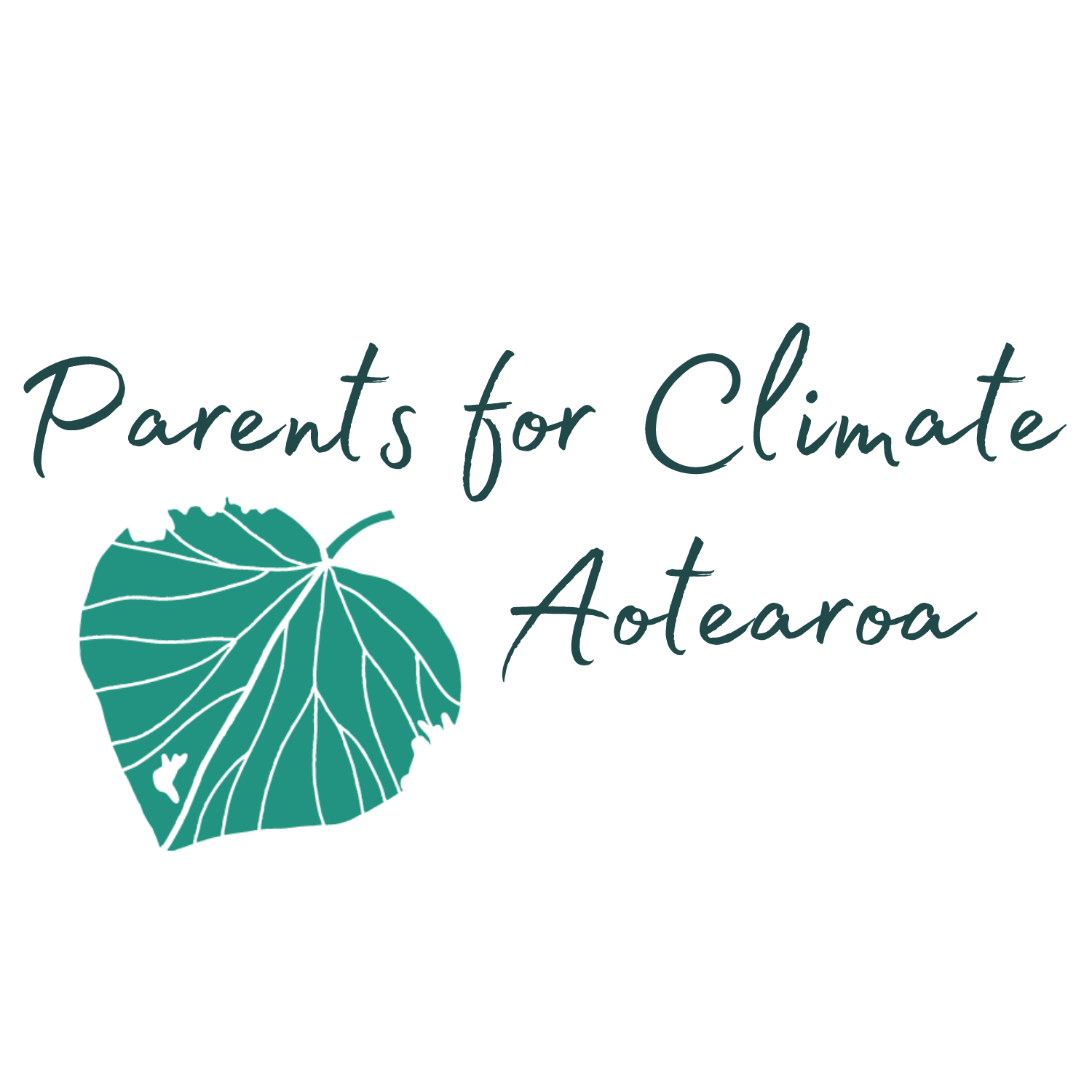
Parents for Climate Aotearoa
Check out their website here.
Read statement
Our tamariki are growing up in a rapidly changing world and climate. Climate friendly transport choices are not the most accessible right now and every lane we liberate moves us not only in the right direction but a better and brighter one.
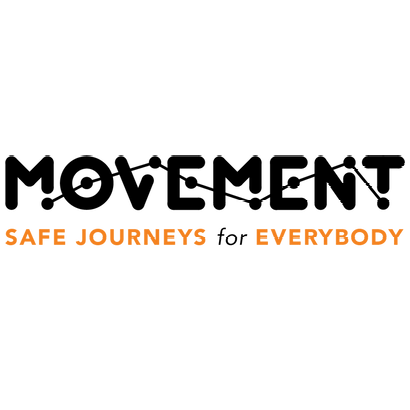
Movement NZ
Check out their website here.

Greenpeace Aotearoa
Check out their website here.
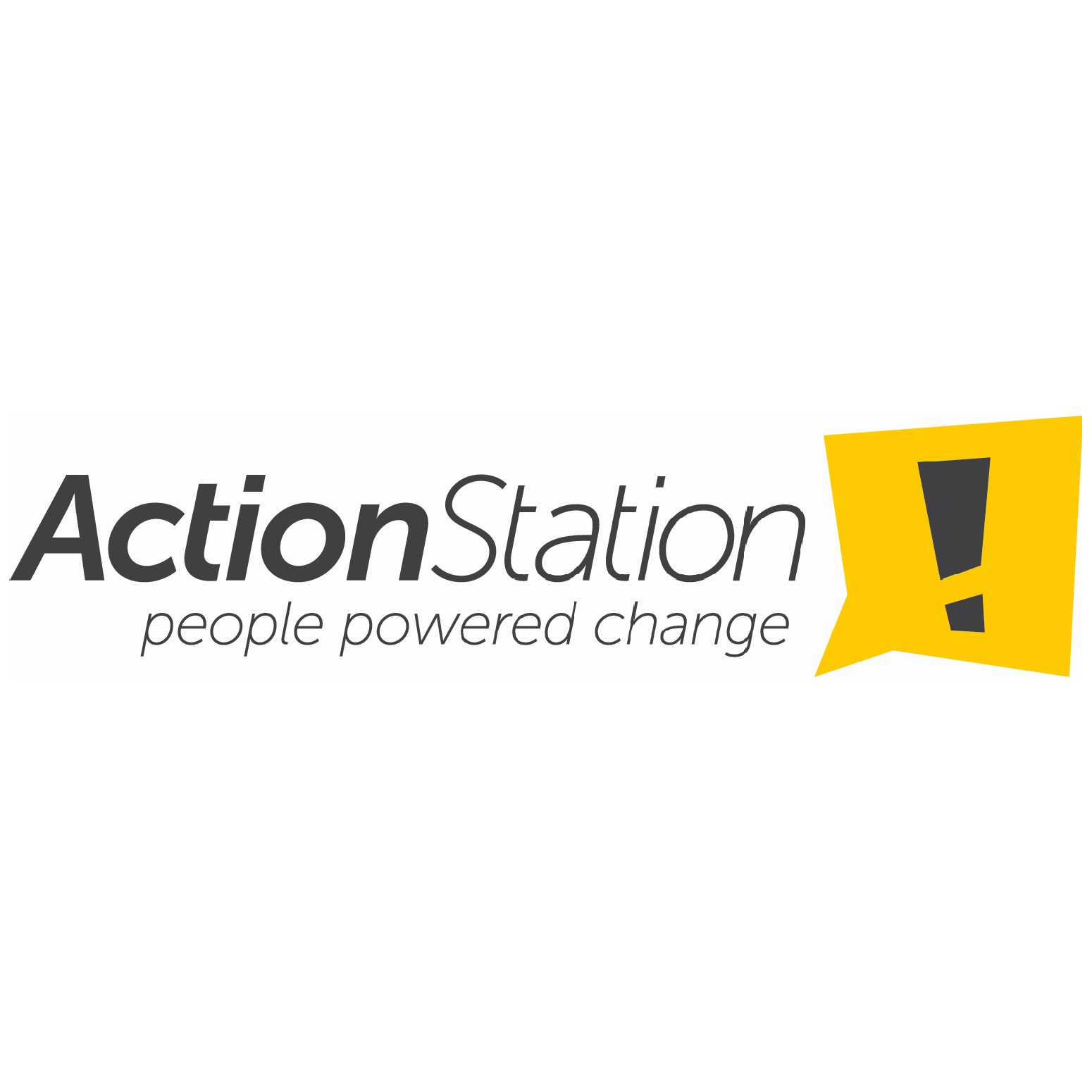
ActionStation
Check out their website here.
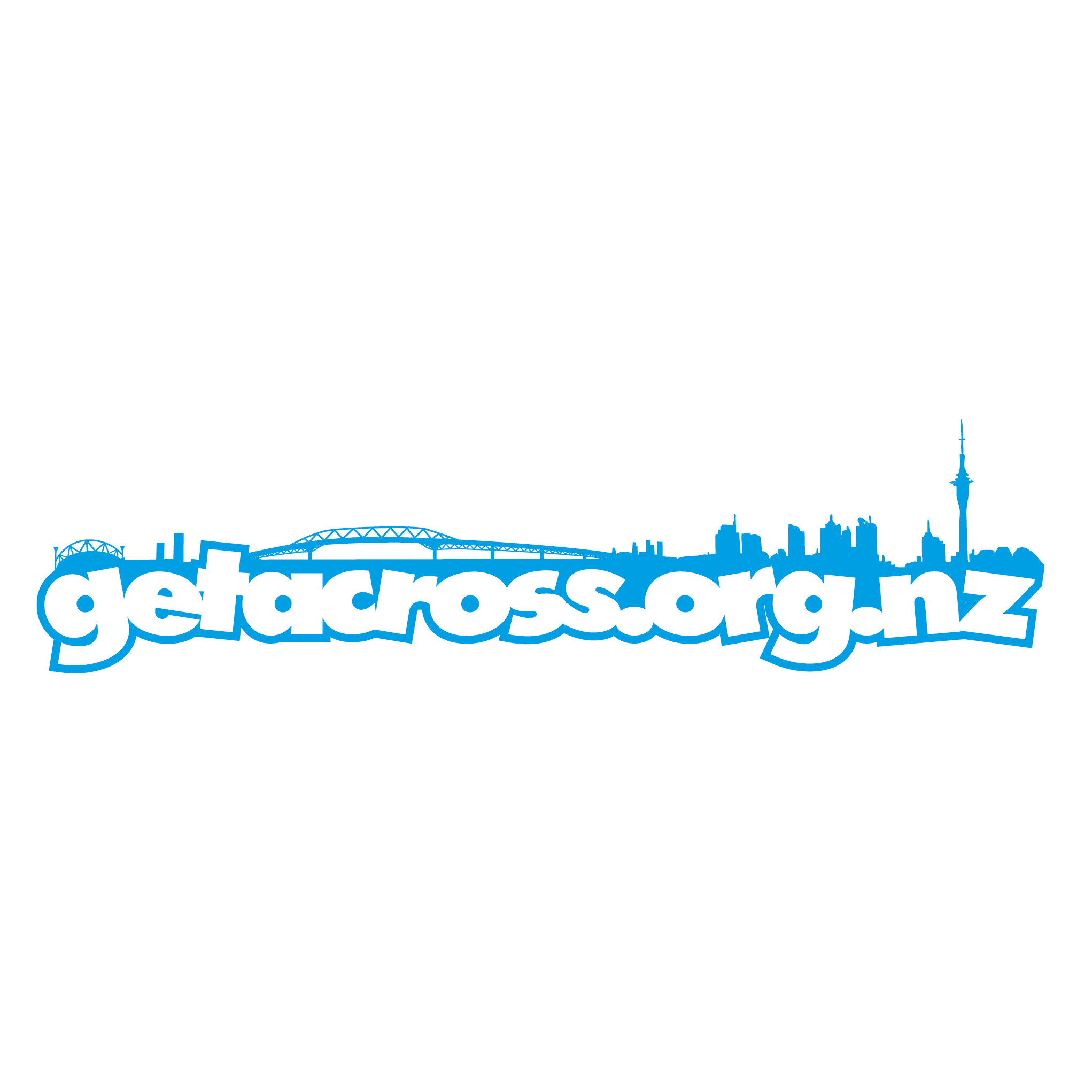
GetAcross
Check out their website here.
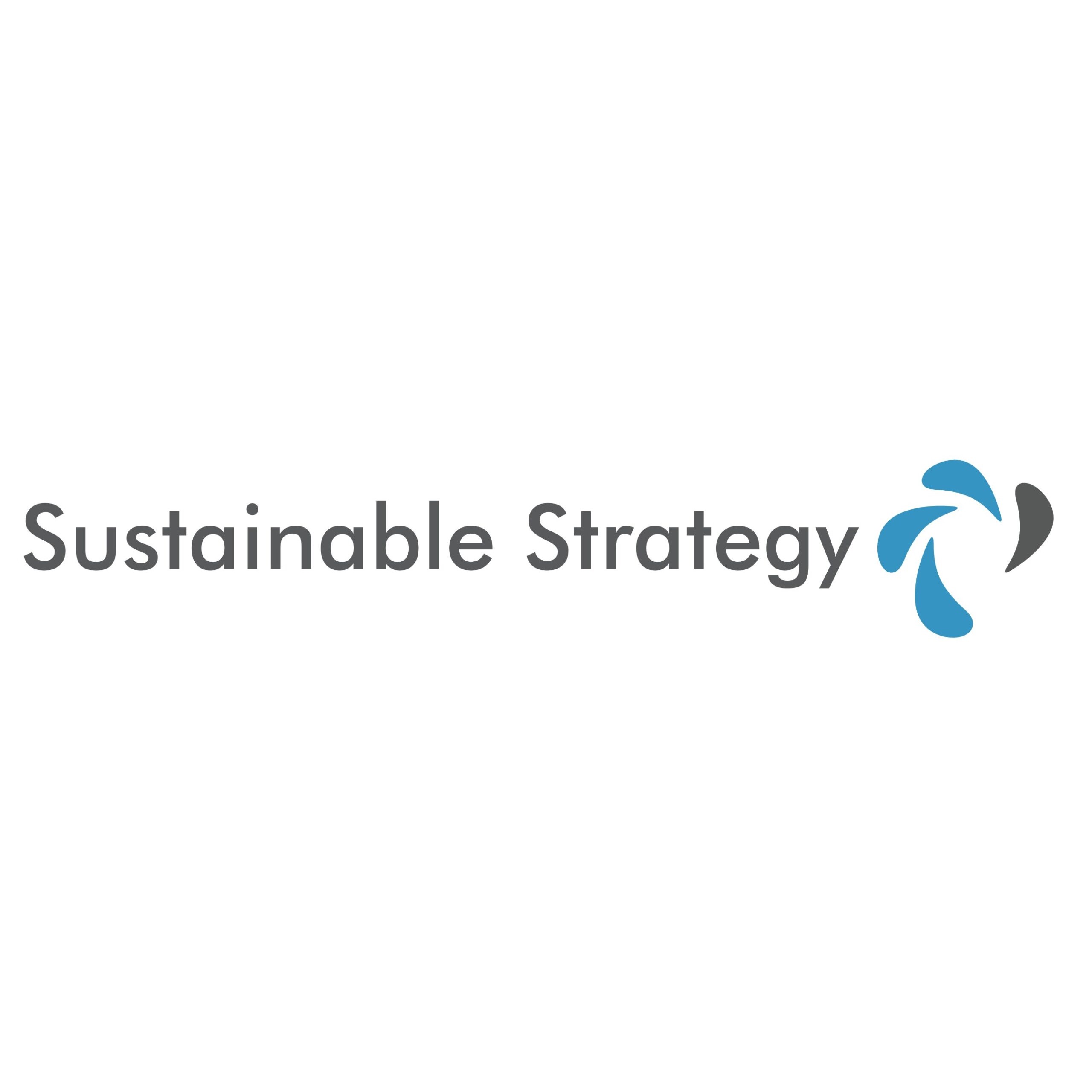
Sustainable Strategy Ltd
Check out their website here.
Read statement
A sensible, low-cost decision to get bikes, e-scooters and pedestrians using the Auckland Harbour Bridge is a no-brainer for transport planners, the climate concerned and the travelling public. We support this call because the argument to invest in re-purposing a single lane is so compelling from multiple perspectives. Although our dominant motive is fighting climate change through encouraging behaviour change (ours), we also need to radically change our transport investment allocations towards cleaner modes of movement. This decision is the perfect example of that and may have a catalytic effect on future Capex allocations by the transport agencies of national and local government.

Tumeke Cycle Space
Check out their website here.
Read statement
Freeing up one lane on the bridge will…
✔ empower people to choose climate-friendly, active travel
✔ give more transport choice to people who don’t drive
✔ reduce the cost of travel for many
✔ create a more resilient transport system
✔ make more efficient use of our existing transport system
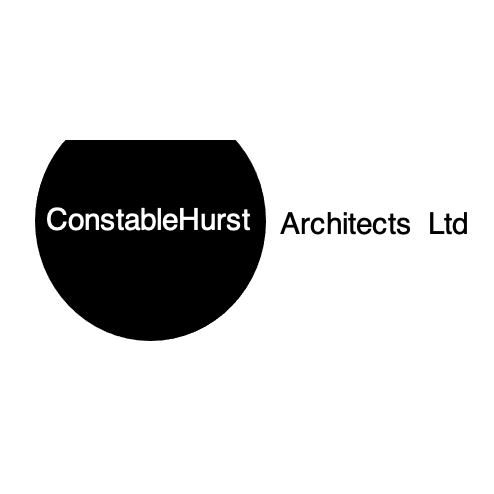
Constable Hurst Architects
Read statement
It is about time we thought and acted like a big city and provide transport options for everyone

eScooter Bitz NZ
Check out their website here.
Read statement
As a e-scooter owner myself, they open up a world of easy transport particularly for those who don’t have access to a car. Opening up the bridge for scooters, bikes and walking would help reduce traffic and emissions and be much more fun!

Sunshine Yates Consulting
Check out their website here.
Read statement
We must improve opportunities for walking, biking and travelling by public transport in Auckland Tāmaki Makaurau. This is the perfect way to do that while finally connecting the city’s two halves for pedestrians and cyclists.

Pathway to Survival
Check out their website here.
Read statement
Liberate the lane now – it’s a good step in the right direction!
For a livable future, we need big cuts to carbon emissions – especially from fossil fuels. So we need safe, connected routes for active travellers to every destination. Our cities can become more affordable, more healthy and more enjoyable to live in.
Plus we can reduce harm from exhaust pollutants that also poison ecosystems and kill more people than collisions.
Take the obvious step and Liberate the Lane! People will come.
Better yet, plan for the future we need – one with many fewer car trips and many more active travellers. Liberate two lanes now!
More of what we need for a livable future: www.pathwaytosurvival.nz

Restore Passenger Rail
Check out their website here.
Read statement
RPR follows the science. The conservative IPCC says it is urgent that emissions are decreased. To zero. The highest emissions in this city comes from transport. We need urgent transition to cycling, pedestrian, ability and micro transport along with free public transport. This needs to include the harbour crossing which can be done immediately with just one lane.

MeloYelo
Check out their website here.
Read statement
Cycling improves health and happiness. Opening access will increase the opportunity for commuting, recreation and tourism in the wonderful city of Tāmaki Makaurau.
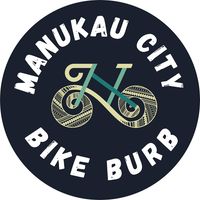
Manukau City Bike Burb
Check out their Facebook group here.
Read statement
Opening a lane in the bridge is the quickest and most effective way of getting more people on bikes moving around the city. It reduces costs for families, reduces congestion and emissions for the city. It needs to happen!
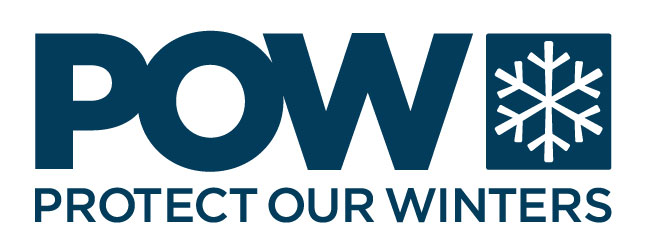
Protect Our Winters
Check out their website here.
Read statement
Better, safer options for biking will mean more people on bikes, less cars, and a city we can be proud of. POW NZ supports the Liberate the Lane campaign as part of a linked up cycle network so we can all ride safely to school, work, and around our city.
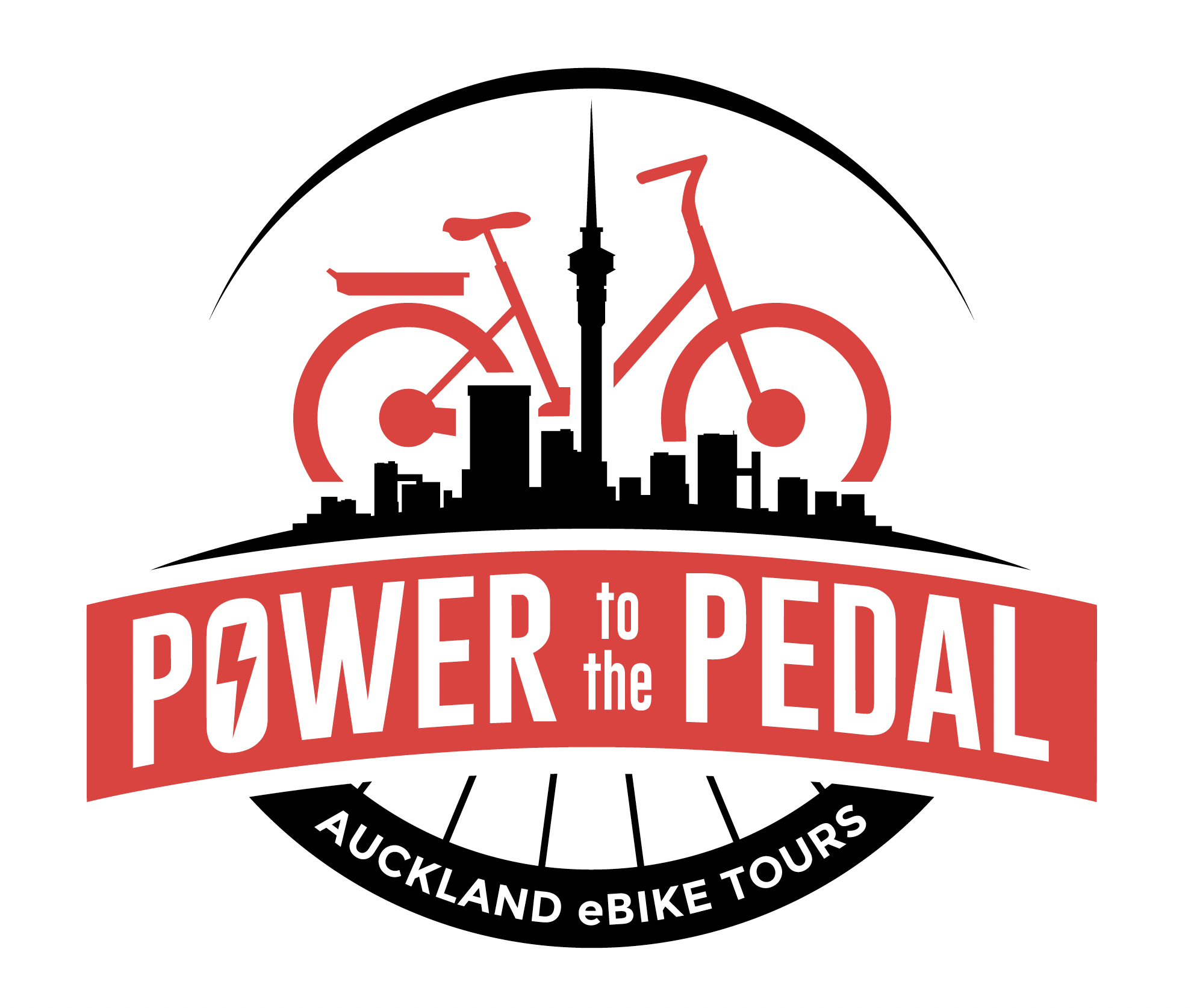
Power to the Pedal
Check out their website here.
Read statement
As a provider of electric bike tours around central Auckland, we showcase the city and its amazing cycleways. The glaring omission in our cycleway network, however, is a viable harbour crossing for bikes. The recent announcement of the cancellation of a number of ferry services will put even more pressure on the remaining ferry crossings and further reduce the already limited space for bikes on the ferries. We would love to ride across to the North Shore with our guests – to showcase the historical locations and great hospitality options over there. But at the moment, that’s not practically possible. We strive to offer a zero-emission experience, so driving our guests across the bridge with our bikes on a trailer would be nonsensical. Liberating a single lane (out of the 8 existing lanes) on the harbour bridge for bikes is the most logical solution for a significant gap in our cycleway network.
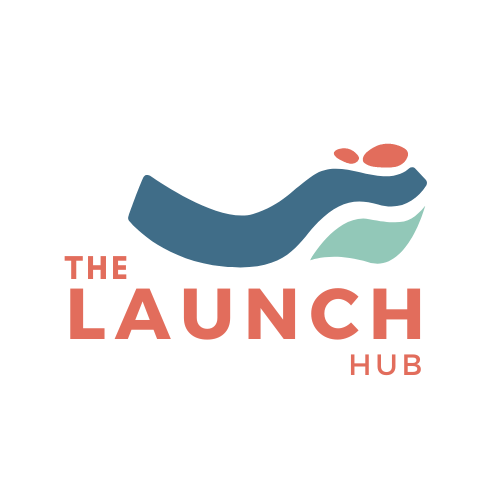
The Launch Consulting
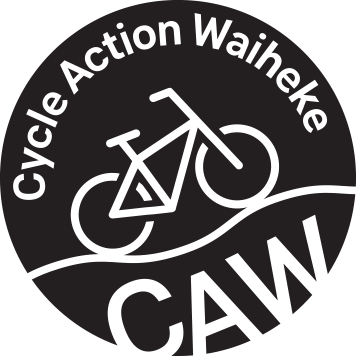
Cycle Action Waiheke
Check out their website here.
Read statement
Waiheke islanders often rely on their bike to access all parts of Auckland city as their bike comes with them into downtown on the ferry. Liberating the lane means a whole lot more of the North shore is accessible. We need more options to get around and not just be reliant on cars! This is why Cycle Action Waiheke supports liberating the lane on the Auckland Harbour bridge.

Sills van Bohemen
Check out their website here.
Read statement
Sills van Bohemen supports all efforts to encourage more people to ride bikes and for people to get to the other side on foot.
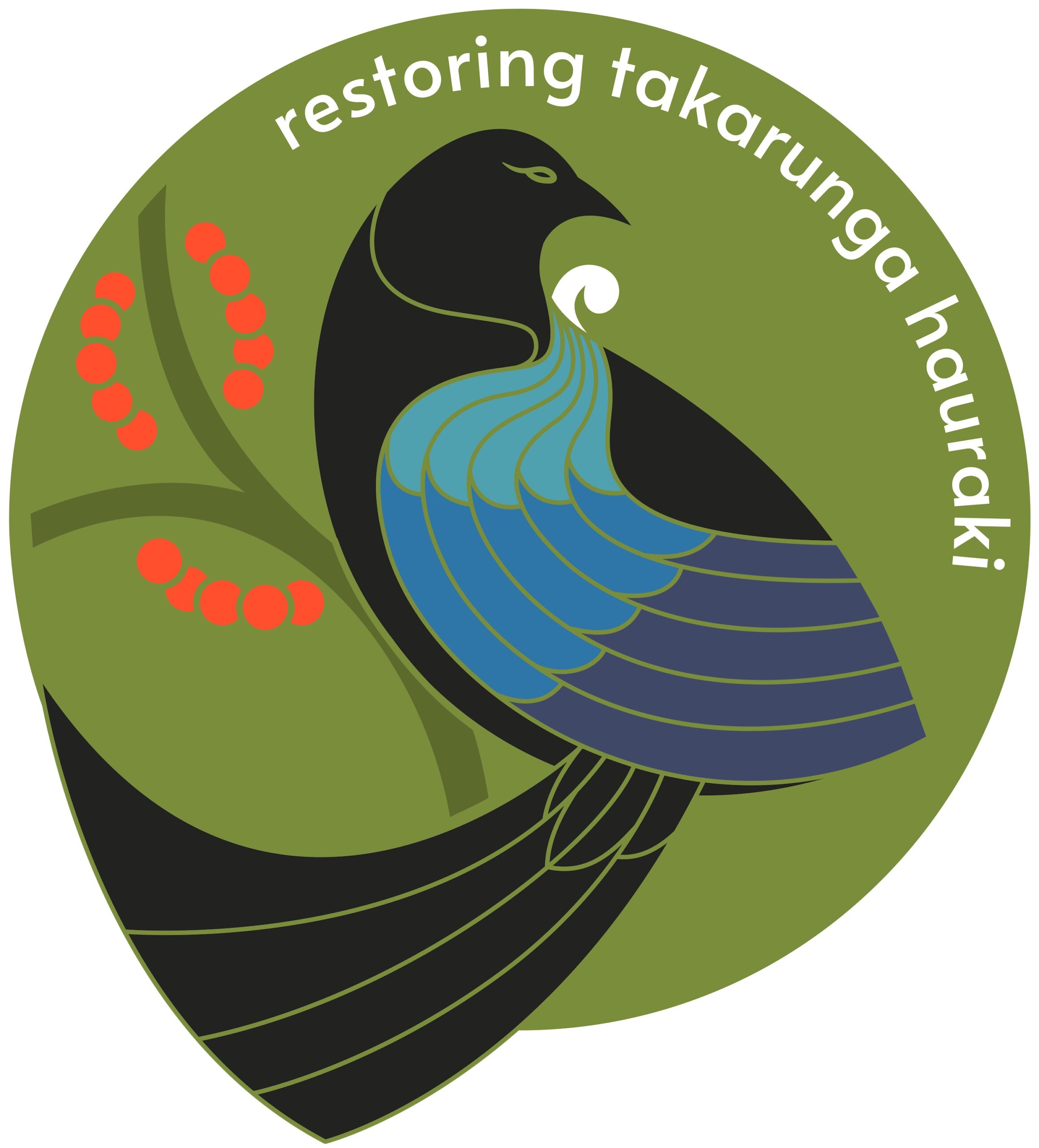
Restoring Takarunga Hauraki
Check out their website here.
Read statement
We advocate for emissions free transport. We see a bike lane as being good for drivers as it reduces congestion when more people bike around Tamaki Makaurau. Currently Ferries can’t cope with demand for bikes to get to the city, we need more alternatives.
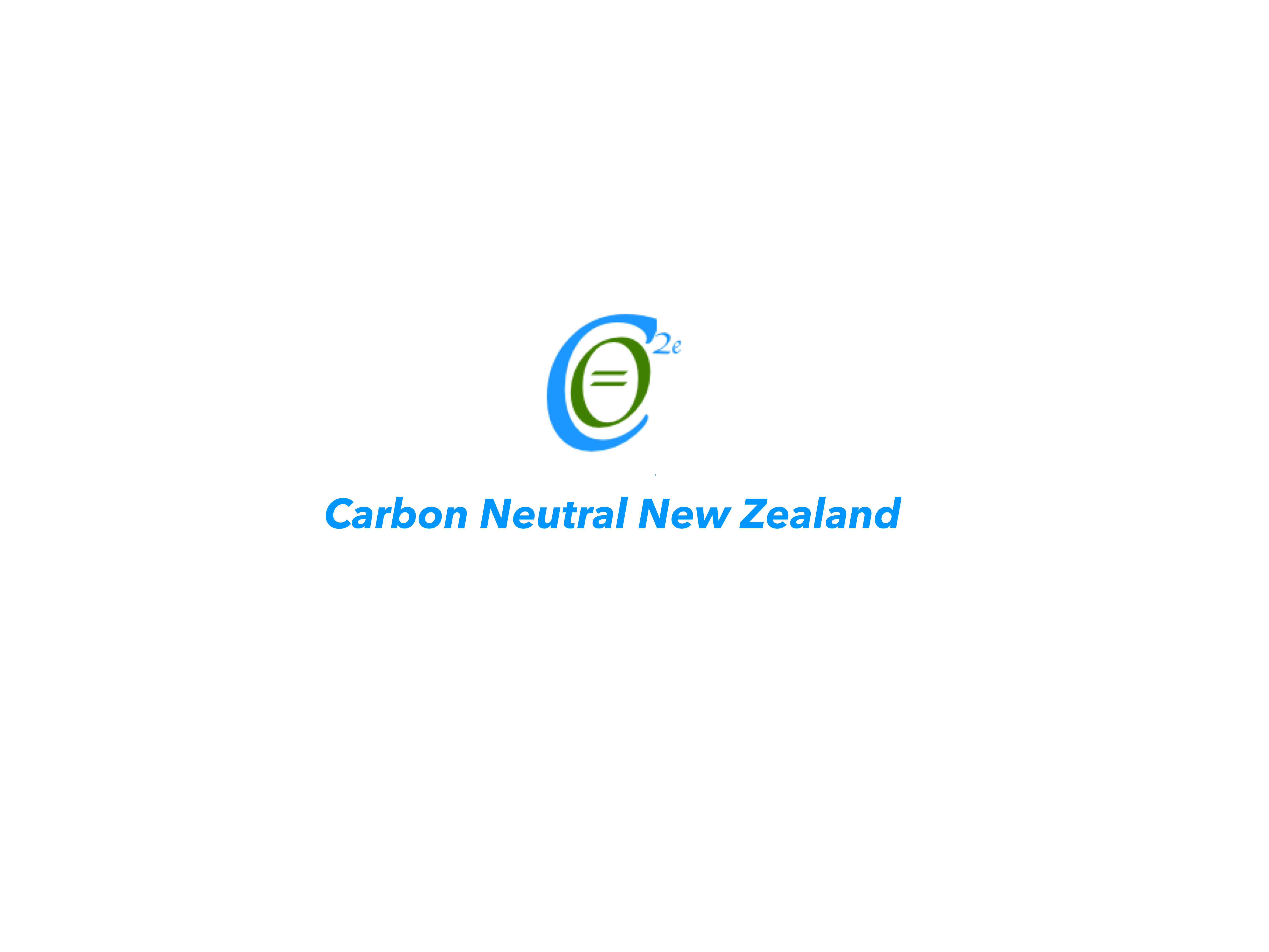
Carbon Neutral NZ Trust
Check out their website here.
Read statement
A mode shift to active transport options is essential if Auckland is to achieve its planned reductions in greenhouse gas emissions and to adapt to the climate emergency. The connection between the North Shore and Auckland City is a vital component to achieve the city’s 2030 climate targets.

FREEd Electric Scooters
Check out their website here.
Read statement
FREEd scooters is all about getting people around with zero emissions. We love getting folks to ditch the car and get on a scooter (or bike). Using a bike or scooter is better for emissions and congestion.
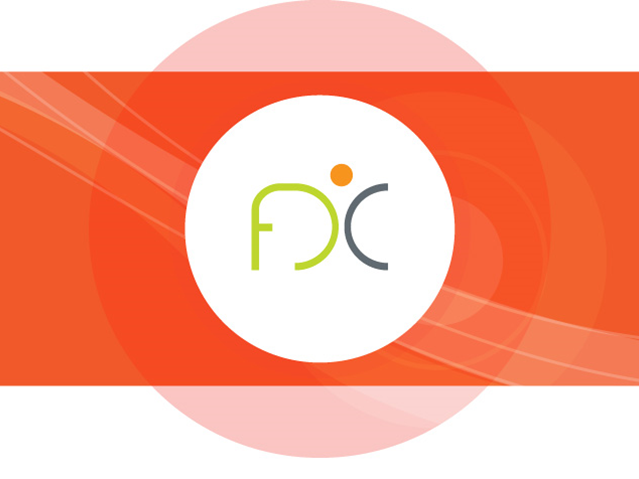
FXC
Check out their website here.
Read statement
Most of our travel within Auckland is by bike – saving parking time and providing a fitness break for our people.

Waiheke Resources Trust
Check out their website here.
Read statement
We advocate for unrestricted access to pedal-powered transport on the Auckland Harbour Bridge as it aligns with our commitment to promoting sustainable and inclusive urban mobility. Opening up the bridge to cyclists and pedestrians not only enhances connectivity but also fosters a healthier, more environmentally friendly cityscape, reflecting our dedication to a future where alternative modes of transport are prioritized for the well-being of both people and the planet.
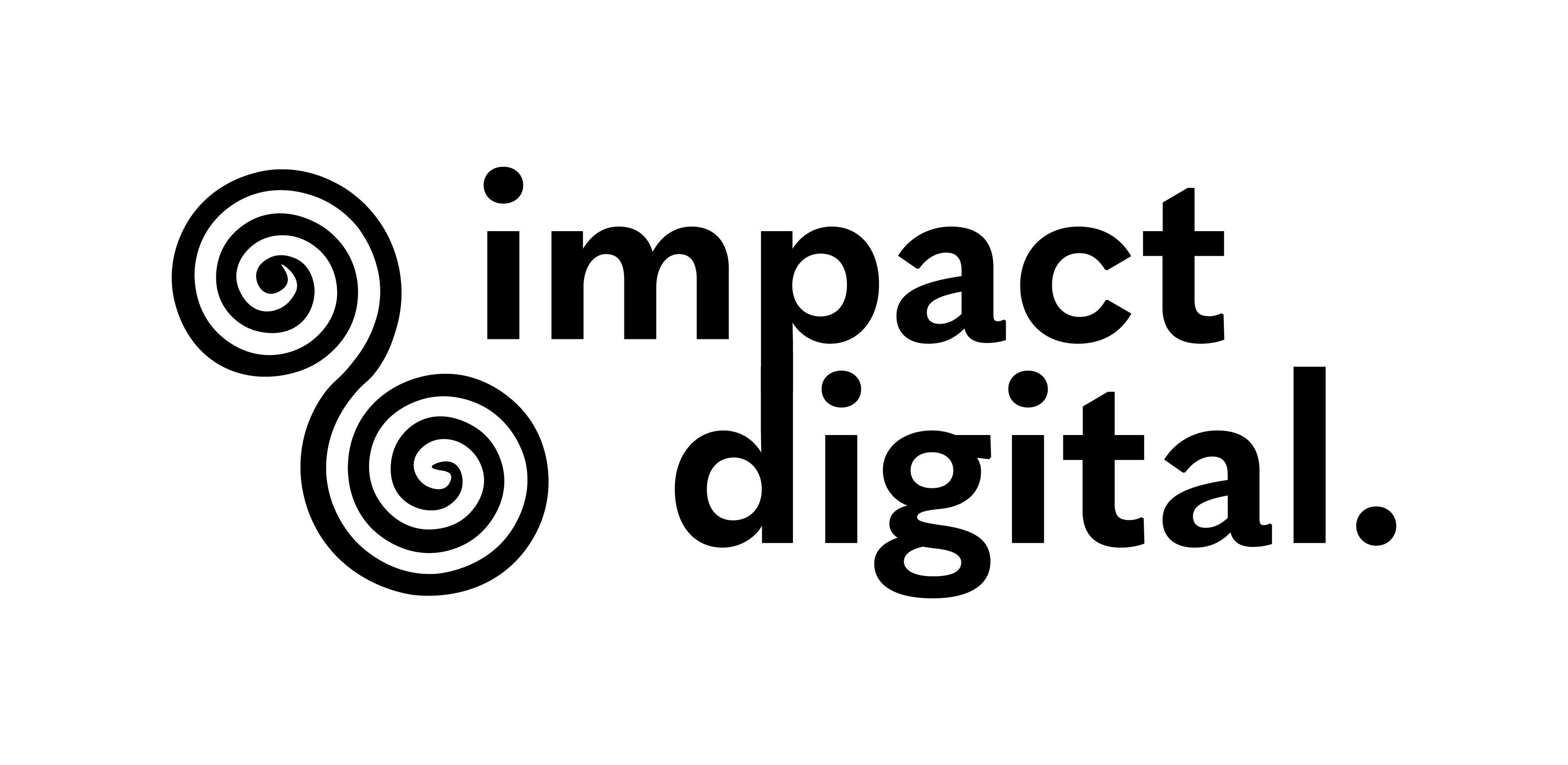
Impact Digital
Check out their website here.
Read statement
We believe liberating a lane on the harbour bridge is a visionary project that will not only provide awesome access for Aucklanders but also set the stage for more sustainable travel options into the future and put Tāmaki Makaurau on the map as a vibrant and dynamic international city respected and admired for it’s forward-thinking transport options.
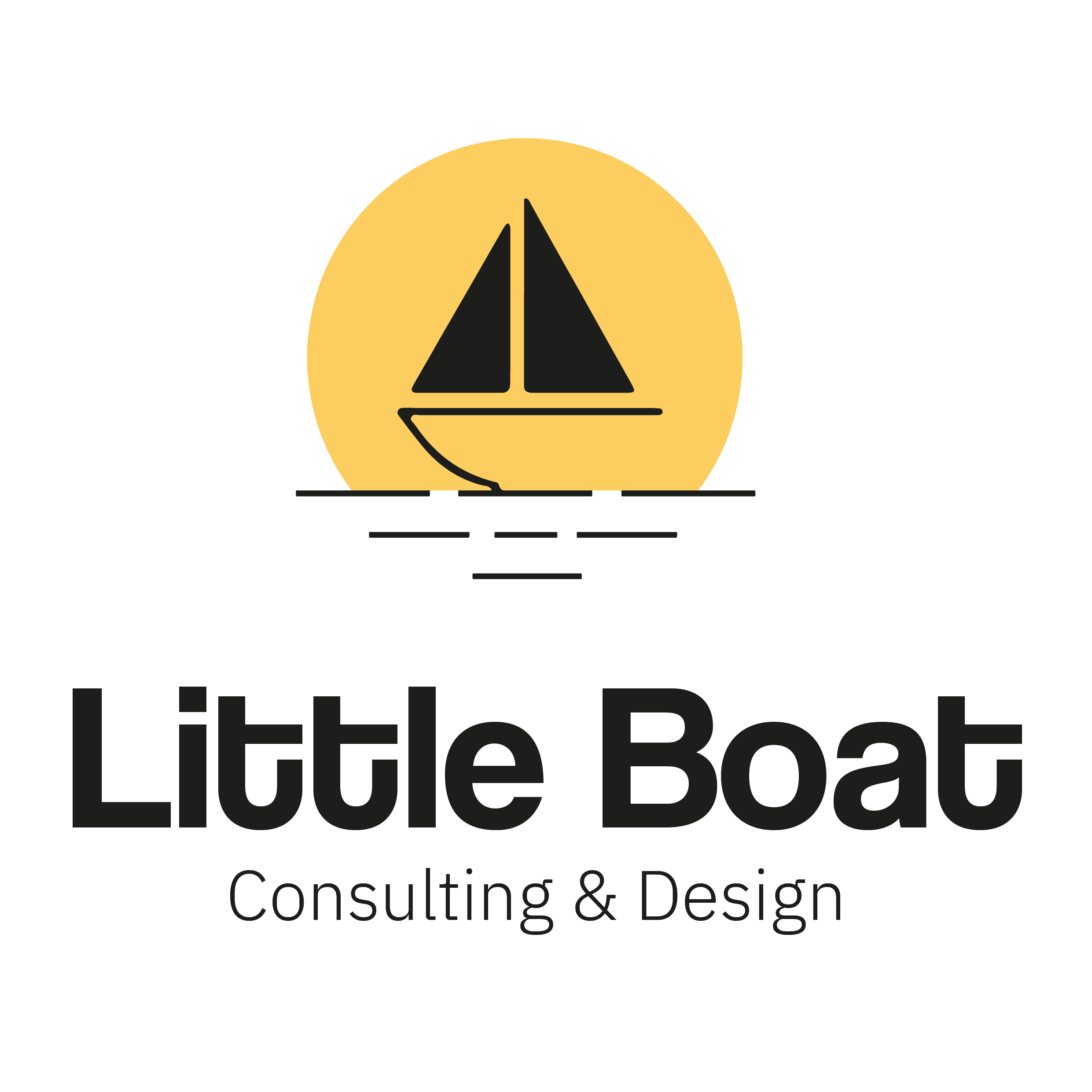
Little Boat
Check out their website here.
Read statement
As a cyclist commuter, I experience firsthand the challenge of abandoning my bike at the shore’s edge. Opening the Auckland Harbour Bridge to bicycles, pedestrians, and other micro-mobility options is not just an aspiration but evidence. By making cycling a truly seamless choice, we can create a healthier, more sustainable city for all Aucklanders. Let’s prioritize safety through careful planning and infrastructure upgrades, while exploring solutions like dedicated lanes on other bridges or expanded bike storage at ferry terminals, to unlock a healthier, more connected future for our city.

Manzana
Check out their website here.
Read statement
Cars are not the future of transport. It’s important to think ahead and to connect Tāmaki Makaurau in more ways than roads for cars. We need safe ways to walk, cycle, and – ideally preferable options commute by public transport. Liberating the lane would be a step in the right direction.

Western Springs College
Check out their website here.

Mark Frazerhurst Architects
Check out their website here.
Read statement
Having a choice to efficiently get from A to B within Auckland, under our own power, should be commonplace for those who choose to protect the future of our planet by walking or cycling.

1st Class Gardens
Check out their website here.
Read statement
Traffic congestion is the number one productivity killer for Auckland businesses. Freeing up 1/8th of the bridge to active modes will have a positive effect on business as the mode shift it will enable will lead to less traffic congestion.
Allowing all modes to use a key transport link is the norm in cities the world over. It’s overdue we allow this and make Auckland a greater place to live, work and play.

Rainbow Riders Tāmaki Makaurau
Read statement
Rainbow Riders is a group of LGBTQIA+ cyclists in Tāmaki Makaurau. All of our members currently live south of the Bridge. We know that there are LGBTQIA+ cyclists living on the Shore who would appreciate being able to join Rainbow Riders at events if they could cycle across the bridge.
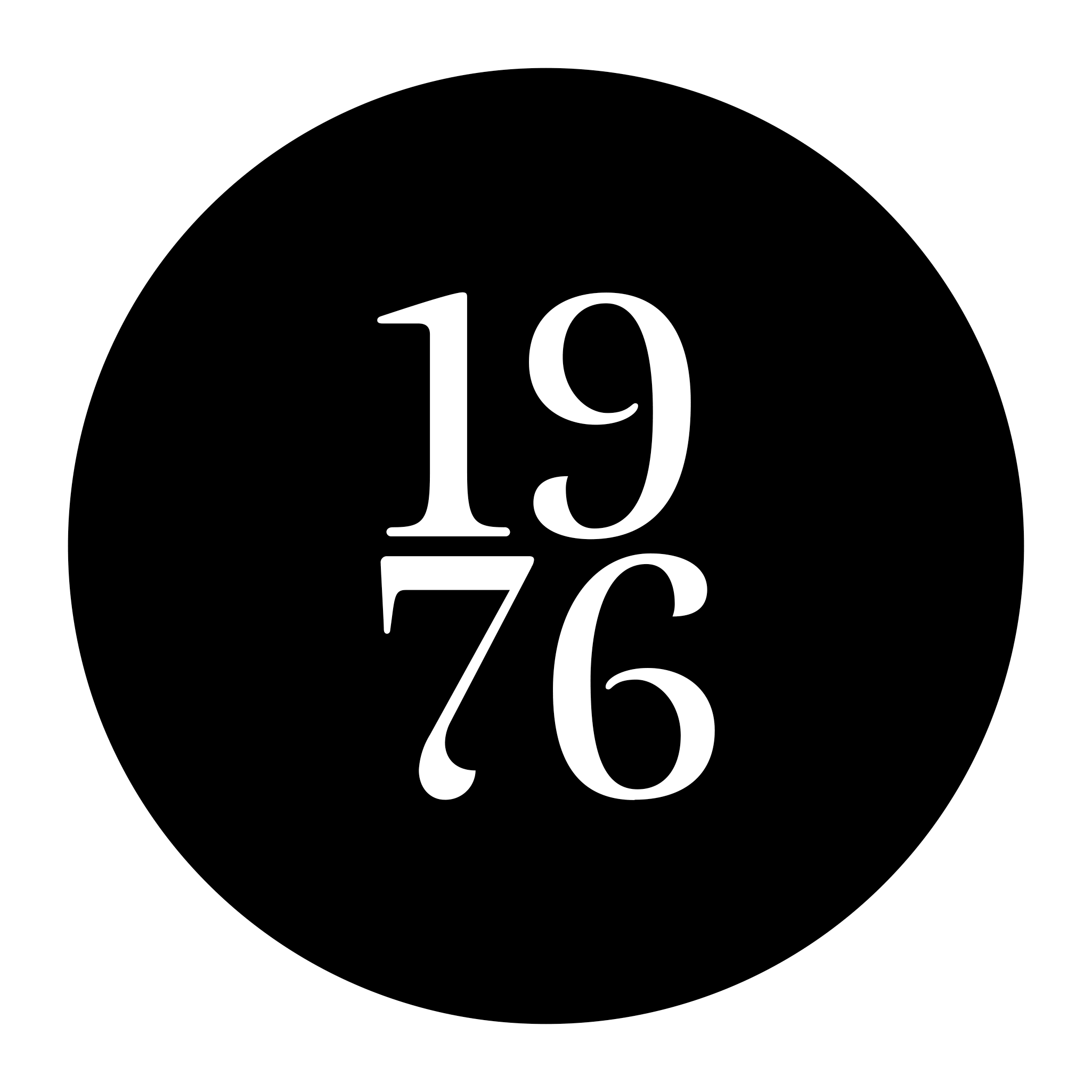
1976 Limited
Check out their website here.
Read statement
If we want Auckland to be a world-class modern city we need a fully connected cycle-way network. The Harbour Bridge can handle a single lane being repurposed for active transport which will benefit all Aucklanders especially those on the North Shore – motorists, cyclists, pedestrians alike. I’m confident if Waka Kotahi would put in a trial of this, the naysayers would realise how wonderful it could be. We should be looking to cities like New York, Sydney, Brisbane, Vancouver and London who have done this.
Recent news and upcoming events!
Frequently Asked Questions
Bike Auckland commissioned SmartSense Ltd to investigate the feasibility of liberating a lane on the Auckland Harbour Bridge for active mobility – walking, cycling, scooting, and other personal mobility options.
Using Waka Kotahi data, Richard from SmartSense has confirmed that Liberating the Lane for walking, cycling and wheeling is absolutely safe, viable, and can be done now!
Read the report for a detailed break down, watch the video, or skip to the question that most interests you.
Who would use a shared path on the bridge?
We’re asking for the same kind of access currently enjoyed by those who go by car: 24/7, seven days a week, weather permitting. That means the lane would be used by everyone and anyone who wants to.
From daily commuters – walking, running, scooting or cycling – to students and shift-workers, tourists and visitors, leisure riders and runners, families on outings, and businesses that use bicycles for delivery and transport.
Data from the 2018 Census suggests there are as many as 80,000 trips each day back and forth across the harbour to locations within biking distance.
5 – 7km is an easy distance for most people to ride a bike, with e-bikes expanding this range to 10 – 15km. Some people will happily cycle even further! Research shows that many Aucklanders already own a bike, and sales of e-bikes and personal e-scooters continue to rise.
The potential is obvious. According to a recent survey by Waka Kotahi (January 2023), almost every Aucklander has travelled over the bridge in the last year, and 66% say they would walk or cycle across the harbour, if it were possible.
Moreover, this is an equity issue. More than 28% of Aucklanders* don’t or can’t drive, and at least 60% of Aucklanders say they would ride a bike if it were safe.
Will the bridge wobble when people walk, scoot or cycle on it?
During ordinary use the bridge will be secure and stable when people are crossing by bike, scooter or foot. The bridge is strong and will last for a very long time; it will not be adversely impacted by opening a lane for people-powered transport – it might even benefit from the overall lighter load as people are significantly lighter than cars!
The details:
- The two outer most lanes on both sides of the bridge are “clip ons” – they were attached to the side of the bridge in September 1969
- When a substantial amount of people (eg. over 1600) are all walking together on both lanes of a single clip-on, it will move, which can feel alarming
- Waka Kotahi found a solution to the issue in 2010; dampers can be used to stop the movement from occurring
- The clip-ons movement can cause a space between the bridge and the clip-on to open and close, which could cause injury if someone got caught in it
- We are advocating for the single outer-most lane of the Eastern clip-on to become a shared path. This would include a barrier between the path and motor traffic – which would also prevent people from being anywhere near where the clip-on and the rest of the bridge meet (i.e. the area that could cause injury if the movement was occurring)
- Running, cycling, scooting and skating do not cause the bridge to have this movement. It is specifically walking that causes the movement of the clip-on, for science reasons (resonance!)
- It is predicted that a shared path over the Harbour Bridge would have a peak usage of 500 people walking on it all at once (and significantly more people on bikes!). This is much fewer walkers than would cause it to move
- However, if the bridge clip on was used for a large protest march it could cause an issue, so Waka Kotahi should still put dampers in place to make sure it is safe during those instances
- Additionally, moving vehicles off one lane and replacing them with people on lightweight bikes means the bridge will see less wear and tear over all. While Waka Kotahi have given us no reason to believe the bridge clip-ons will need replacing any time soon, reallocating a lane to active transport should extend the bridge’s life
How do we know this? Bike Auckland commissioned Richard Young, an independent Traffic and Civil engineer (of Smartsense Ltd.), to investigate reallocating a lane on the Harbour Bridge for walking and cycling. He made an Official Information Act request to Waka Kotahi and the information released revealed that Liberating the Lane for walking and cycling is absolutely still safe, viable, and can be done now! You can read more about his findings here.
How would people access the liberated lane?
The Easternmost lane should be liberated as it is the most sheltered from the wind (predominantly Westerlies). On the City side, the lane would link to the existing paths and greenways in Westhaven. On the North Shore side, it would connect into the Northern Pathway which is being completed beside SH1.
Originally designed to connect with the now-scrapped Skypath crossing, the Northern Pathway is already open from Albany to Constellation station, with a plan to extend to Akoranga. It wouldn’t take much to continue that connection to the Harbour Bridge itself.
This would link the North Shore directly into the isthmus walking and cycling networks, and vice versa.
This map shows potential options for accessing and exiting the liberated lane.
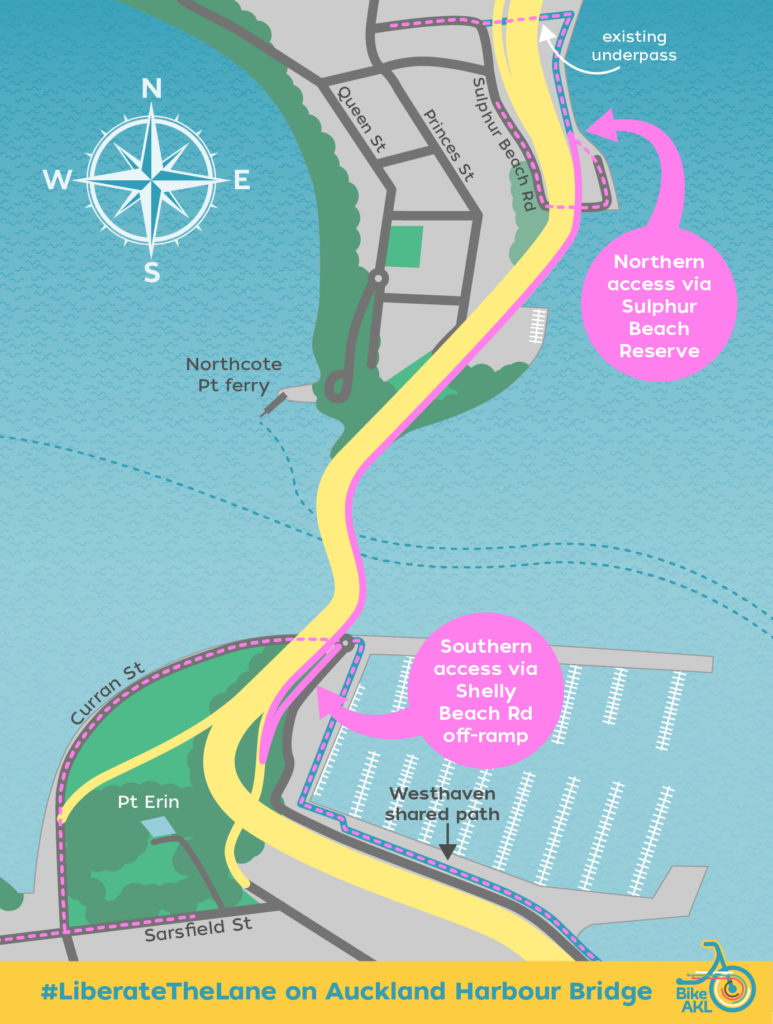
What about safety?
Any design for a people-powered transport across the Harbour Bridge will necessarily include solid barriers to protect people from motor traffic and an anti-climb barrier along the outer edge to keep everyone safe. Cities all over the world have walking and cycling paths designed in this way, which have worked safely for decades.
Bike Auckland comissioned SmartSense Ltd to investigate the feasibility of reallocating a lane on the Harbour Bridge towards walking and cycling and the resulting report showed it absolutelly can be done safely. SmartSense Ltd has created the following design solution:
- A shared path for active modes on the most easterly clip-on lane. The east side provides for better protection from wind (predominantly Westerlies), easy access on and off the bridge, and stunning views of the harbour and city
- Shared path has 4metre width which is within the Austroads guidance for gradient (5%) and width with the expected usage
- The use of free-standing HV2 Steel/Concrete composite barriers with mesh fence between the shared path and the motor traffic. This is a relatively lightweight barrier which Waka Kotahi has already approved the use of in Aotearoa NZ
- An anti-climb barrier along the eastern edge of the bridge for suicide prevention, as has been effective on comparable bridges overseas
- Potential for dampers to be placed between the bridge and the clip-on (to prevent movement caused when a significant number of pedestrians march across at the same time)
- Potential for a 60km/h speed limit for the motor-traffic in the lane adjacent to the shared path for additional safety if considered required
You can see more about the report SmartSense created here.
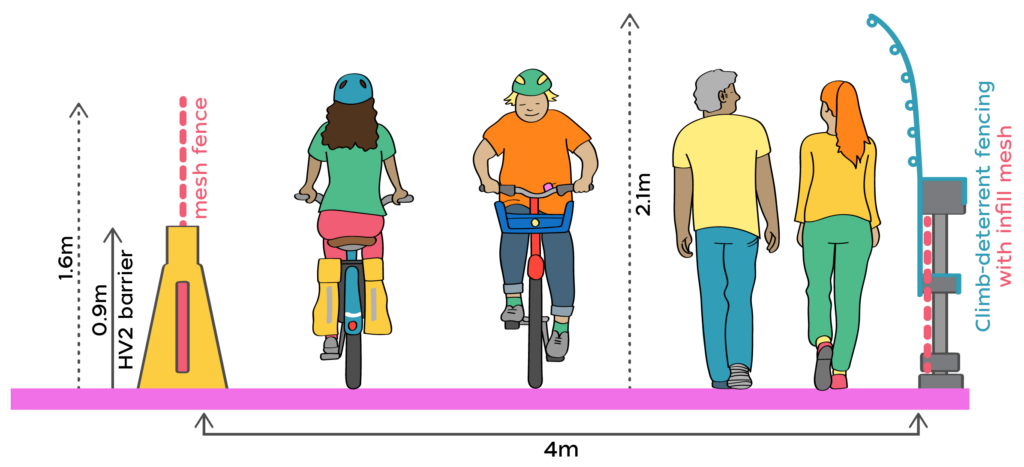
What about traffic fumes?
Cycling on the bridge alongside traffic is actually less ‘fume-y’ than walking on many busy urban streets. That’s because the fumes are mixed with a healthy dose of fresh air, not trapped between buildings.
Here’s the research: a 2011 NZTA report concluded that ‘car commuters were overwhelmingly seen to be exposed to higher concentrations of total air pollutants than those who walk, cycle or use public transport.’
And moving people out of cars will help improve air quality for everyone, including those in the central city, which often records poor air quality results.
What about motor traffic?
Auckland Harbour Bridge isn’t operating at capacity and traffic volumes have fallen since 2017. In any case, the bridge isn’t the chokepoint. Traffic generally flows smoothly along it. The onramps are the problem.
Freeing up a lane won’t slow traffic on the bridge itself. In fact, it will give people the opportunity to change the way they travel, swapping from car to bike. The result will be less congestion across the whole Auckland transport network, including Onewa Road, the motorway approach at Northcote point, through Spaghetti Junction and up Parnell Rise. With fewer private motor vehicles on the wider network, people who need to drive will experience shorter overall journey times. It’s a win for everyone.
We commissioned Richard Young, an independent Traffic and Civil engineer (of Smartsense Ltd.), to investigate reallocating a lane on the Harbour Bridge for walking and cycling. Using Waka Kotahi data he has confirmed that Liberating the Lane for walking and cycling would not have significant impacts on traffic. You can read more about his findings here.

In a meta study of over 70 road reallocation projects across 11 countries, researchers concluded that ‘significant reductions in overall traffic levels can occur, with people making a far wider range of behavioural responses than has traditionally been assumed.’ when road space is reallocated for cycleways or public transit.
We’ve got our own examples in Tamaki Mākaurau Auckland. For example, converting a lane on Ian Mckinnon Drive in the central city into a protected cycle path has seen a huge increase in people travelling to the city on bikes and scooters, with no negative impact on traffic flows.
This has also been done successfully in many places overseas. Vancouver’s Burrard Bridge is a good example. In July 2009, the city removed a vehicle lane on the Burrard Bridge and converted it to cycle lanes. While there were some loud voices against it at the time, a decade later the Burrard Bridge cycle lanes enjoy overwhelming support. They’re now the single busiest section of cycle lane in North America, recording more than a million cycle trips each year.
Is it flat enough?
There are steeper sections on the existing cycle network (e.g. parts of Nelson Street, Grafton Gully, Stage 2 of Glen Innes to Tāmaki Drive) and hundreds of people on bikes use those cycleways every day. The bridge’s gradient is a maximum of 5% and is less steep than Grafton Gully, a frequent cycle route for many. We have seen children having a blast riding the bridge during rallies. But for those who could be put off by the gradient, e-bikes work wonderfully and are becoming more common and affordable. We continue to support the call for e-bike subsidies to make these more available for the wider population.
We commissioned Richard Young, an independent Traffic and Civil engineer (of Smartsense Ltd.), to investigate reallocating a lane on the Harbour Bridge for walking and cycling. He confirmed that it is safe and viable: you can read more about his findings here.
What about the weather?
When it’s raining many people still choose to jump on their bikes for their journeys – and decent rain gear makes it even easier and more appealing.
During Skypath’s design, Waka Kotahi (NZTA) indicated that wind won’t be a problem for most of the year. NIWA data on Auckland’s climate backs this up. It suggests that there are only three to seven days each year when wind speeds on the bridge would make riding unsafe; and some of these times it would be closed to motor traffic too. That leaves 358 days – or 98% – of the year to cycle across!
We commissioned Richard Young, an independent Traffic and Civil engineer (of Smartsense Ltd.), to investigate reallocating a lane on the Harbour Bridge for walking and cycling. He confirmed that it is safe and viable: you can read more about his findings here.
A whole new crossing?
What Aucklanders have been asking for ever since the Harbour Bridge was built – easy walking and cycling access across the Waitematā – can happen now at a fraction of the cost of a new structure, and in a fraction of the time. We need transport choice now.
Though Waka Kotahi’s new crossing options include walking and cycling, they would take more than a decade to build. In the meantime, there’s a huge cost in terms of climate, equity, and health. Freeing up a lane on the bridge now is cheap, fast, and easy – and we can do it as an interim solution so that we have transport options while the new crossing is still being built. One of Waka Kotahi’s proposed options even includes walking and cycling on the existing Harbour Bridge; if this becomes the preferred option they could simply leave the liberated lane in place, saving themselves time and money .
Is there a better alternative?
People deserve the freedom to make their own schedule!
The major appeal of walking, scooting, and biking is the sheer convenience and freedom of movement. Tying that to timetables defeats the purpose. And why pay when you can travel for free under your own steam?
Public transport is an essential option for crossing the Harbour Bridge, and a viable alternative for some people. But routes and stops are fixed and inflexible. Services can be unreliable or cancelled altogether, leaving people stranded. And bus and ferry timetables don’t work for every trip, especially when you start early or finish late.
Why wait to sit on a ferry or bus, or travel out of your way to find one, if you could simply use 15 of those minutes to walk, run, ride, scoot or wheel over the bridge, which is right there and available at any time? Additionally, walking and wheeling is a more climate friendly transport mode, creating zero emissions.
Everyone deserves to have a choice about how they get around, and we can liberate the lane to create that choice now. A 24/7 lane on the bridge gives people the freedom to make their own reliable journeys, free of traffic and independent of public transport constraints.
Bikes on buses?
Buses already struggle to meet passenger demand at peak times, and are currently not permitted nor set up to carry bikes.
We will continue to advocate for the option of carrying bikes on buses, especially while train lines are down. But it will not solve the problem of crossing Te Waitematā by bike. Retrofitting the entire bus fleet with front-mounted bike racks would still only carry three bikes per bus – tough luck families, groups, and anyone travelling at peak!
Liberating the Lane is the simple and speedy solution to enable Aucklanders to have greater transport choice.
How about ferries?
Ferries do currently carry bikes (with no extra fee above the standard ticket price), and we’re grateful that ferry operators strive to accommodate their customers who cycle.
Unfortunately, ferries miss the boat when it comes to meeting our emissions reduction targets, reliable journeys and hours of access. Like buses, ferries fill up at peak times, and are vulnerable to staff shortages, leading to interrupted journeys and stranded customers. Each ferry has a finite capacity for carrying bikes, and it is all too common for riders to be turned away if the ferry is full-up, making them an unreliable option for people trying to cross Te Waitematā with their bikes.
There’s also the cost of travel: many people tell us they go by bike in order to reduce the cost of their commute, and a ferry fare adds a significant cost to each journey. Liberating the Lane frees people from all of those constraints.
Special bike ferries?
Waka Kotahi and others have floated the idea of a dedicated bike ferry service. But these ferries would be as vulnerable to staffing shortages and capacity issues as any other public transport, likewise limited to fixed hours, and costing passengers for their travel. A bespoke bike ferry running back and forth below the bridge would be nowhere near as efficient, available, or affordable as simply Liberating the Lane on the bridge.
Freeing up a lane for walking and cycling is the smartest, simplest and speediest way to give Tāmaki Makaurau what it needs.
Let’s Liberate the Lane, NOW and make an accessible city the main event!
You can help by…
- Signing our open letter to Waka Kotahi – and sharing about it on social media
- Encouraging organisations who represent you (eg. local resident’s association) to sign our open letter
- Encouraging businesses to sign the open letter – tips for these conversatons here!
- Wearing a Liberate the Lane Tshirt!
- Adding a Liberate the Lane stem cap to your bike!
- Using one of these photo frames for your social media profile picture
- Adding this image to your email signature to show your support
- Sharing blogs and positive news stories about this campaign
- Writing your own blog piece or sending an opinion piece to the media
- Downloading and sharing the images (below) online
- Printing posters and putting them up on noticeboards around Tāmaki Makaurau Auckland
- Coming to events and starting some of your own!
- Signing up as a volunteer!
- Donating to the ongoing campaign!
Scroll down to see resources we have made available for you to share!
Note: to download an image click it and a new tab will open. You can then right click the image and select “save image as…” A window will open up prompting you to choose a location to save it to on your computer and to rename the image if you want to. If you do not choose a location it will most likely default to your downloads folder.
